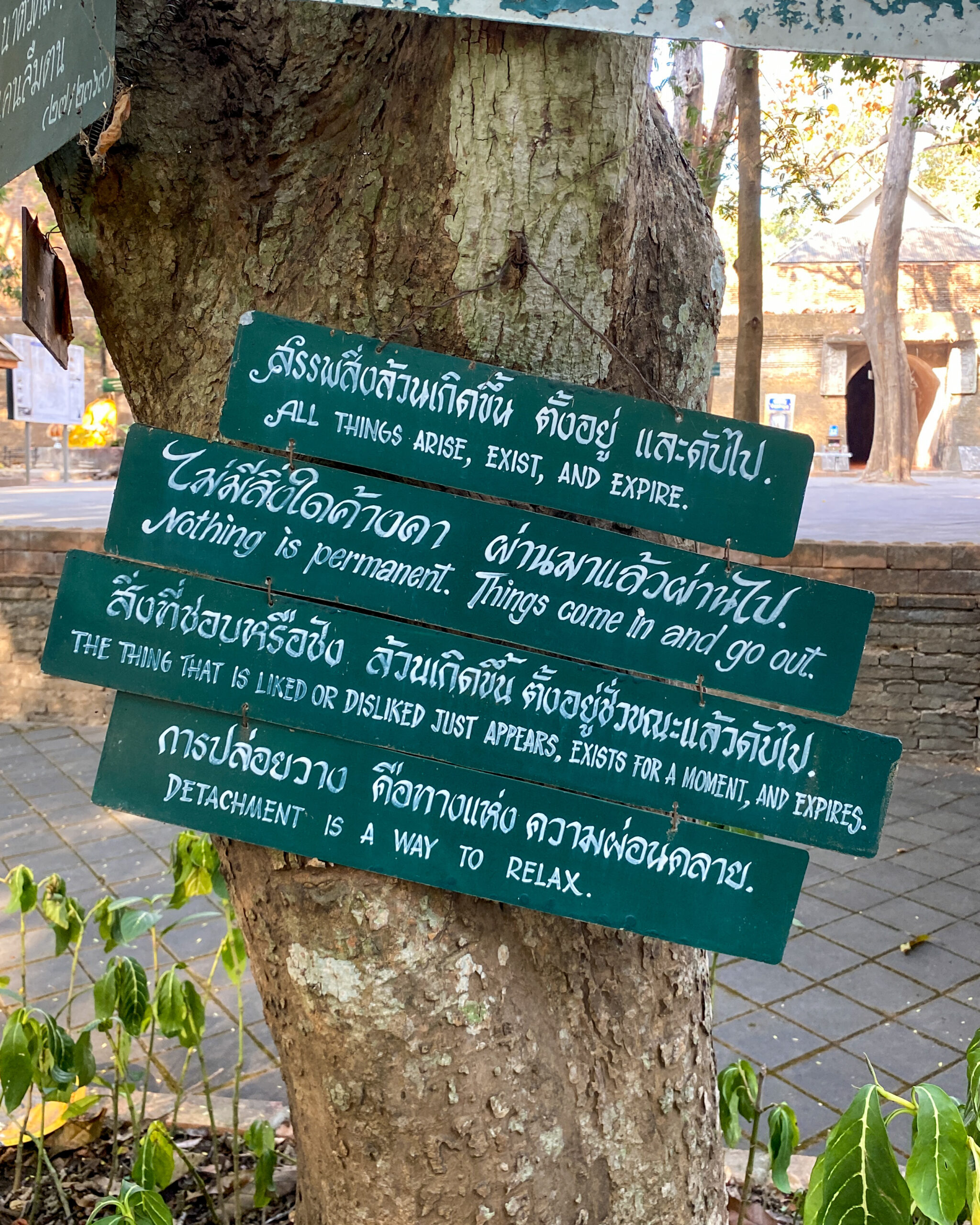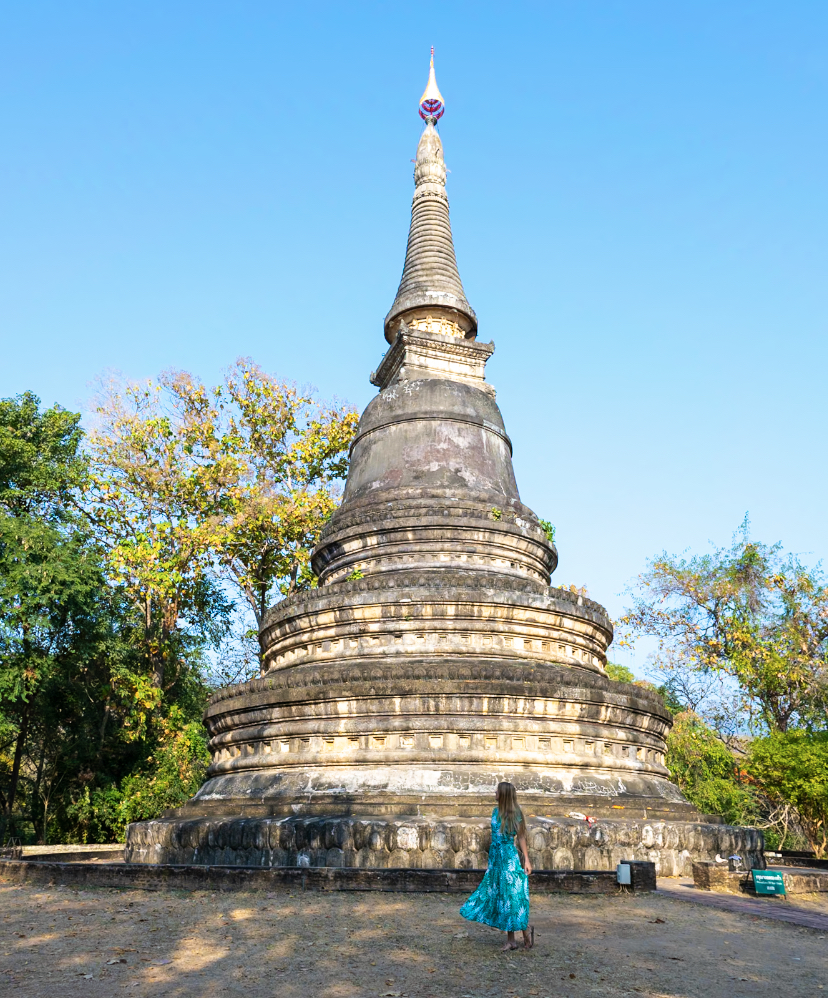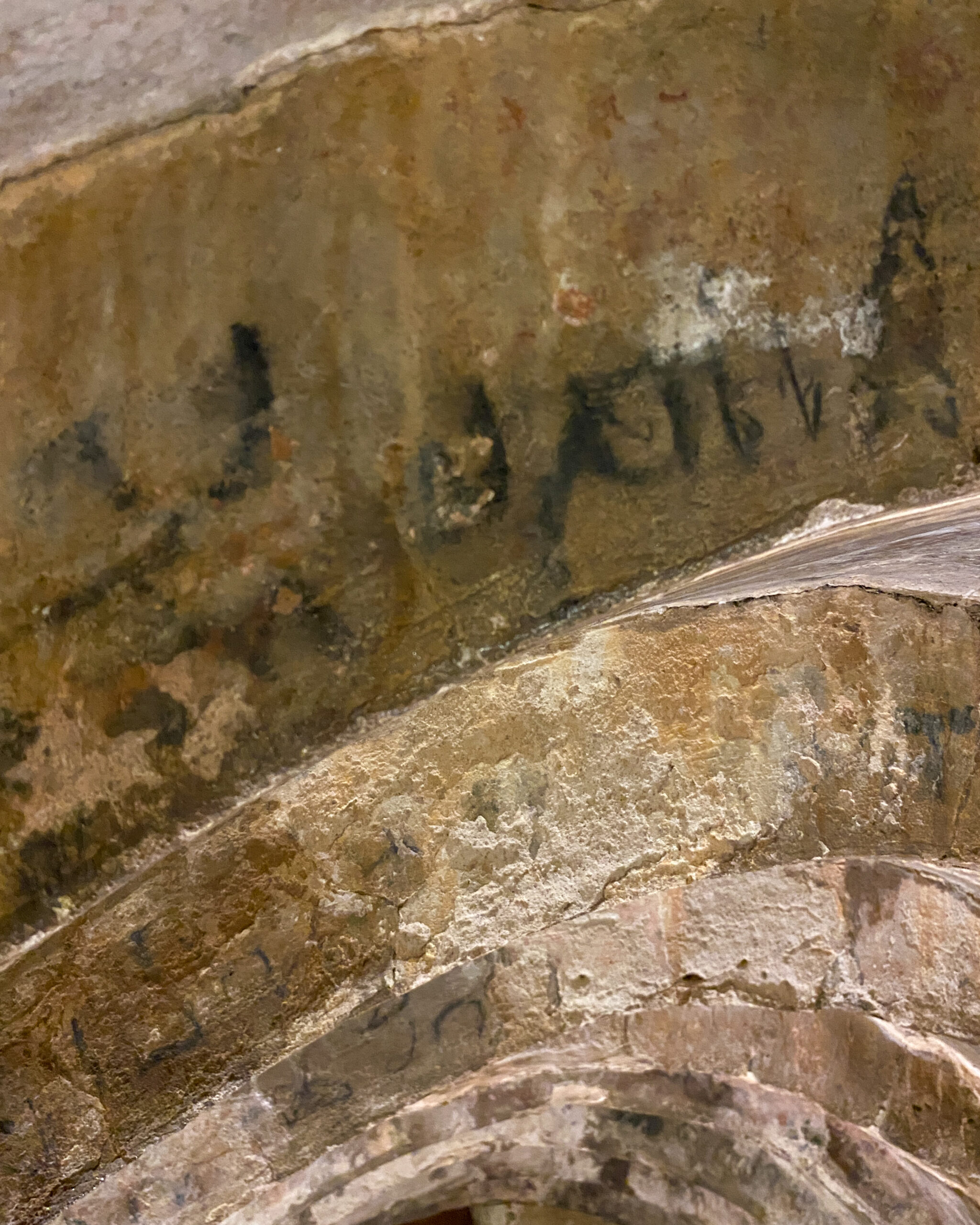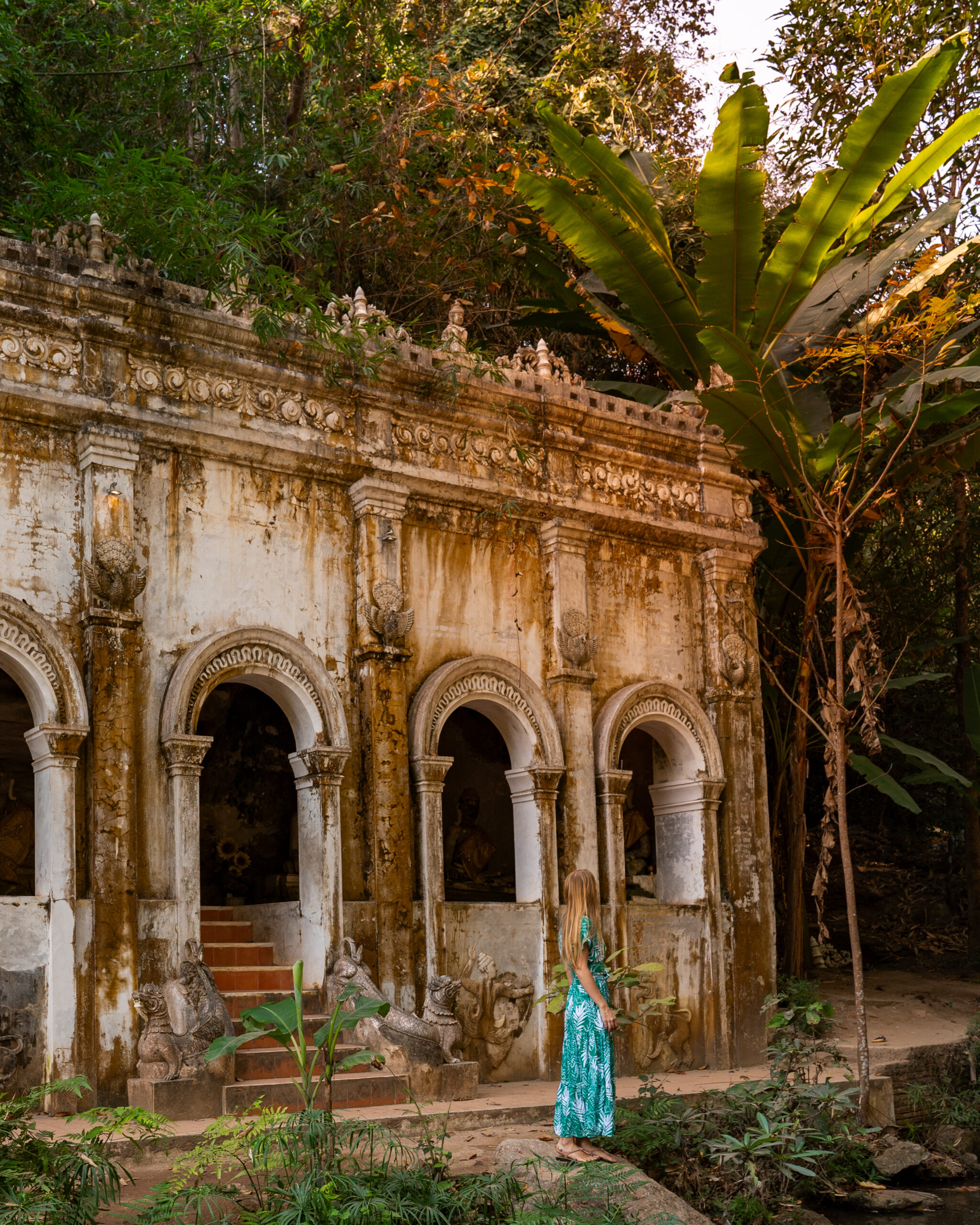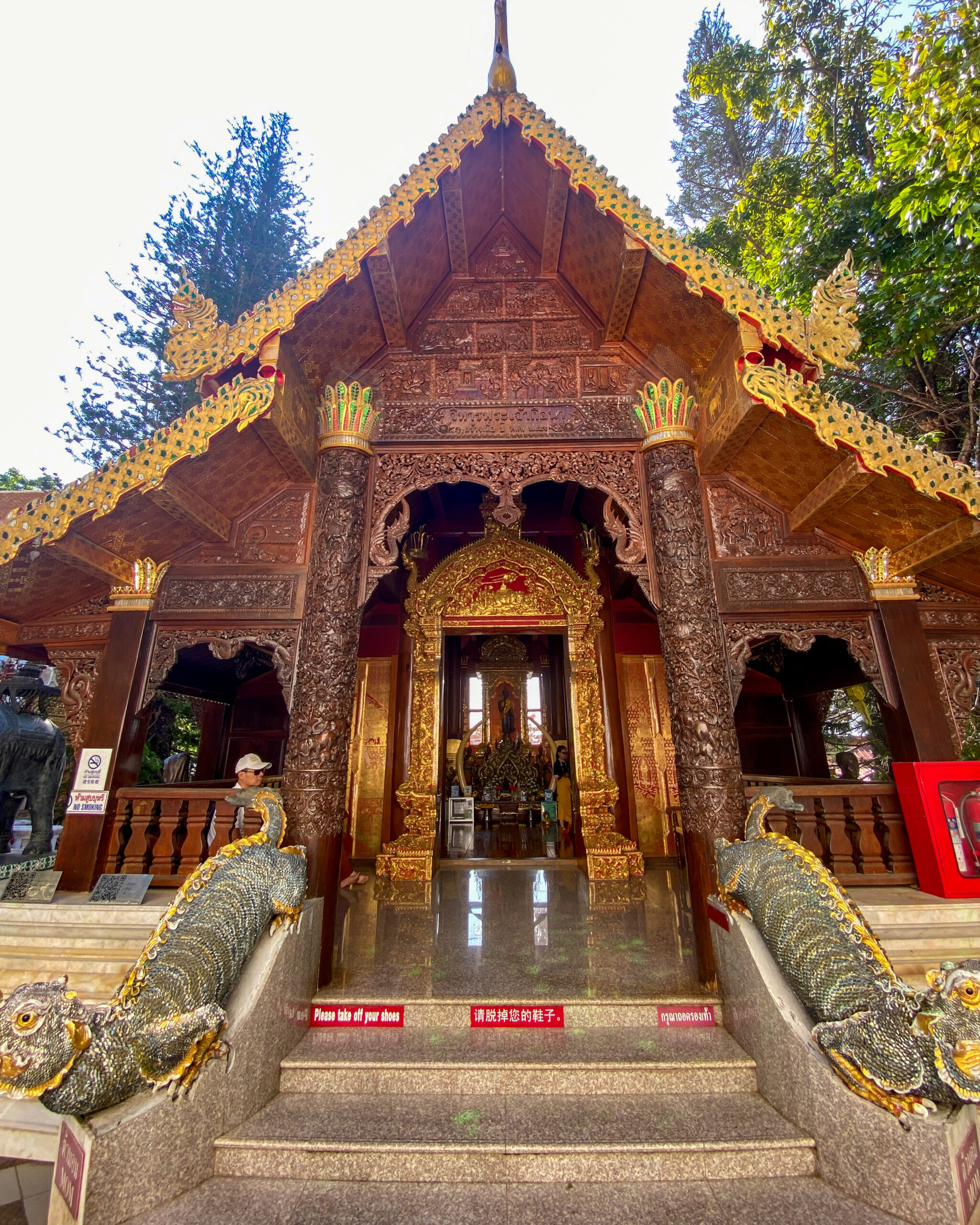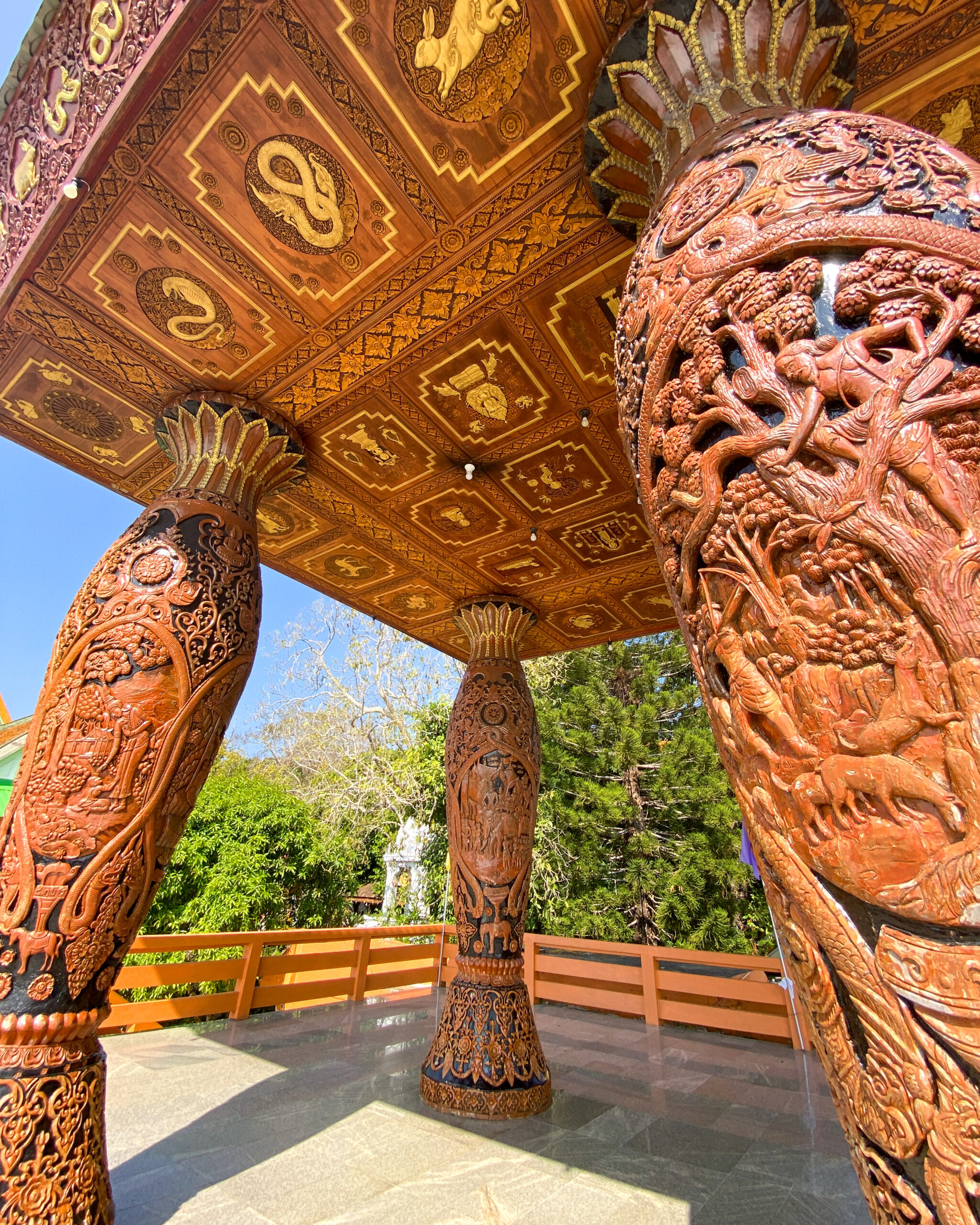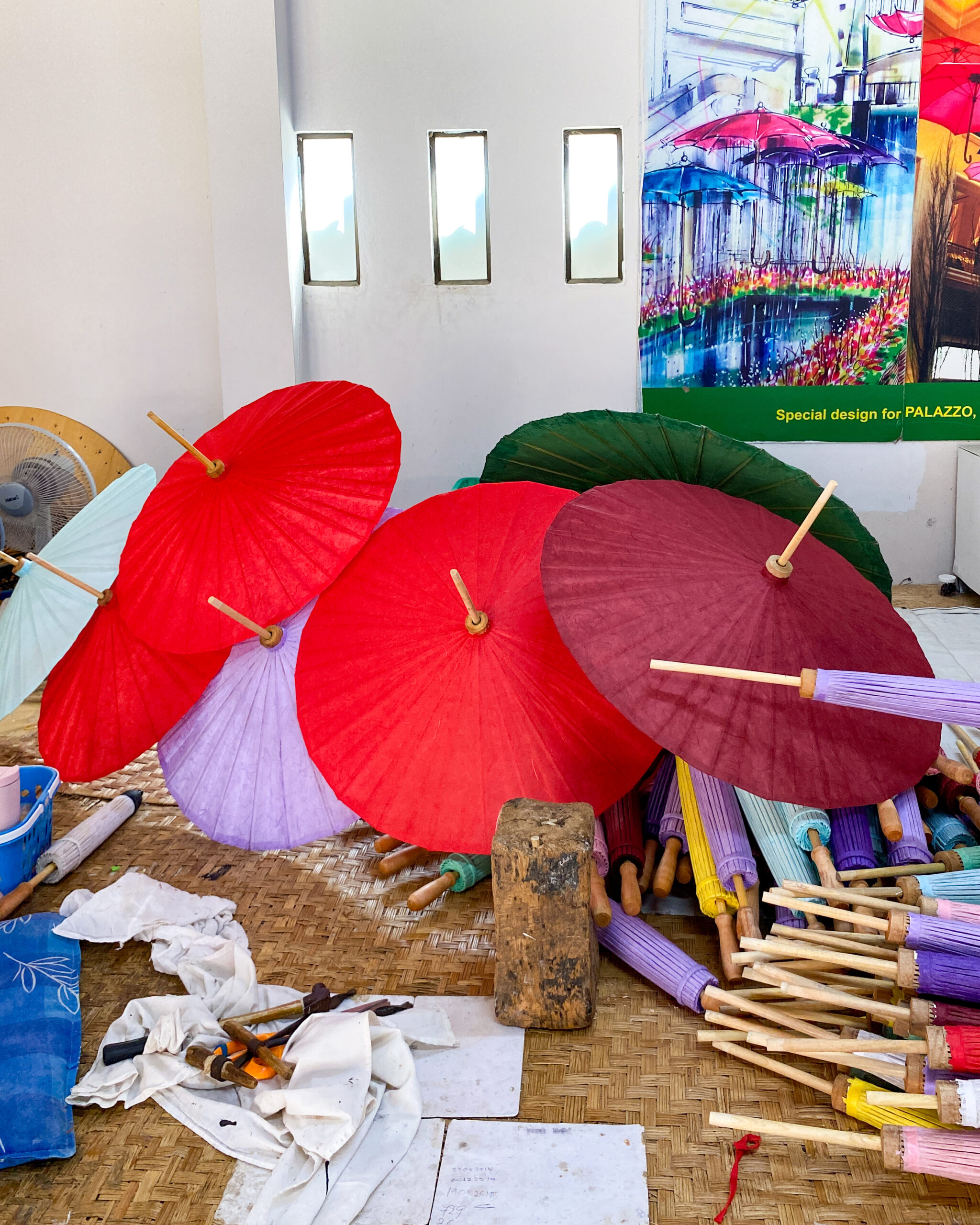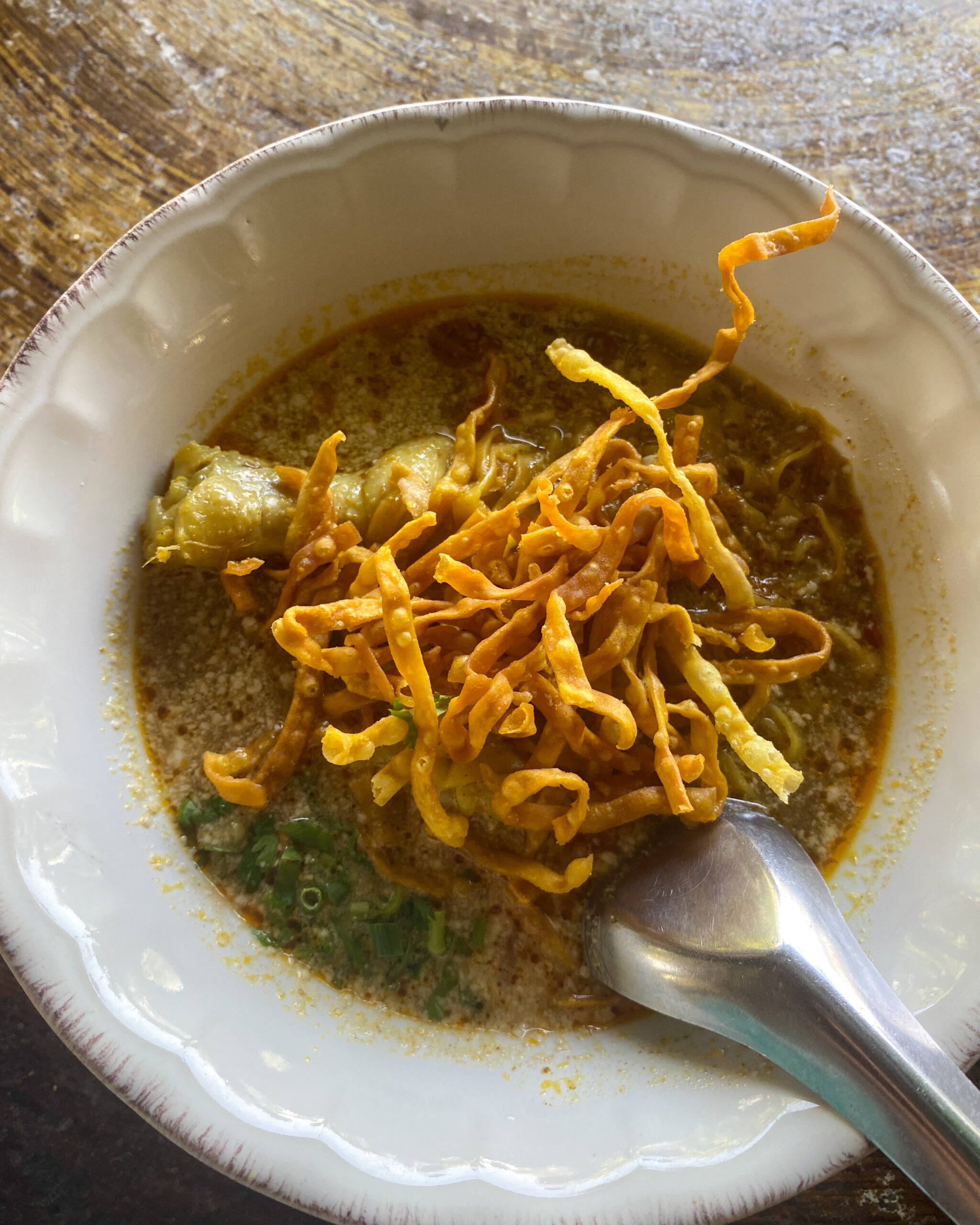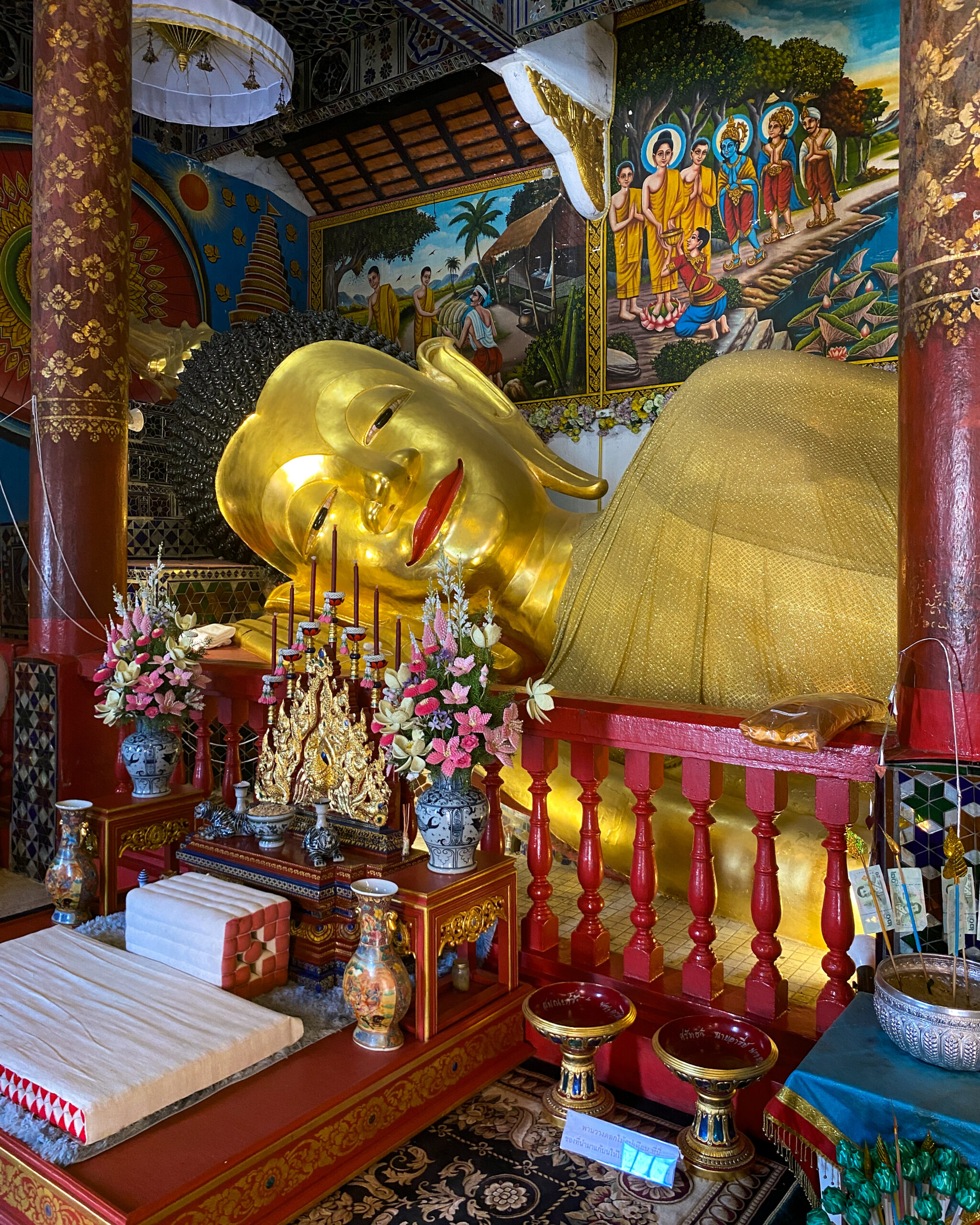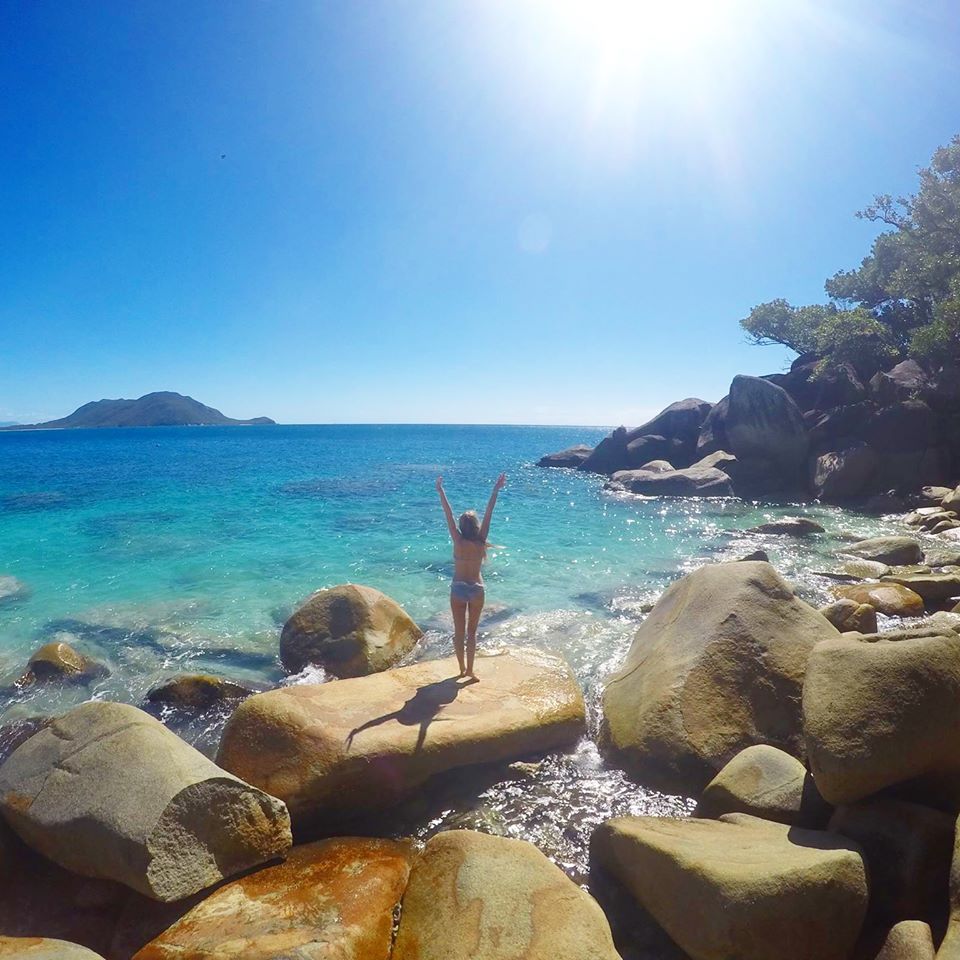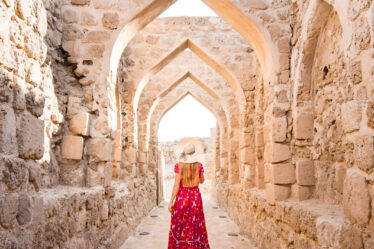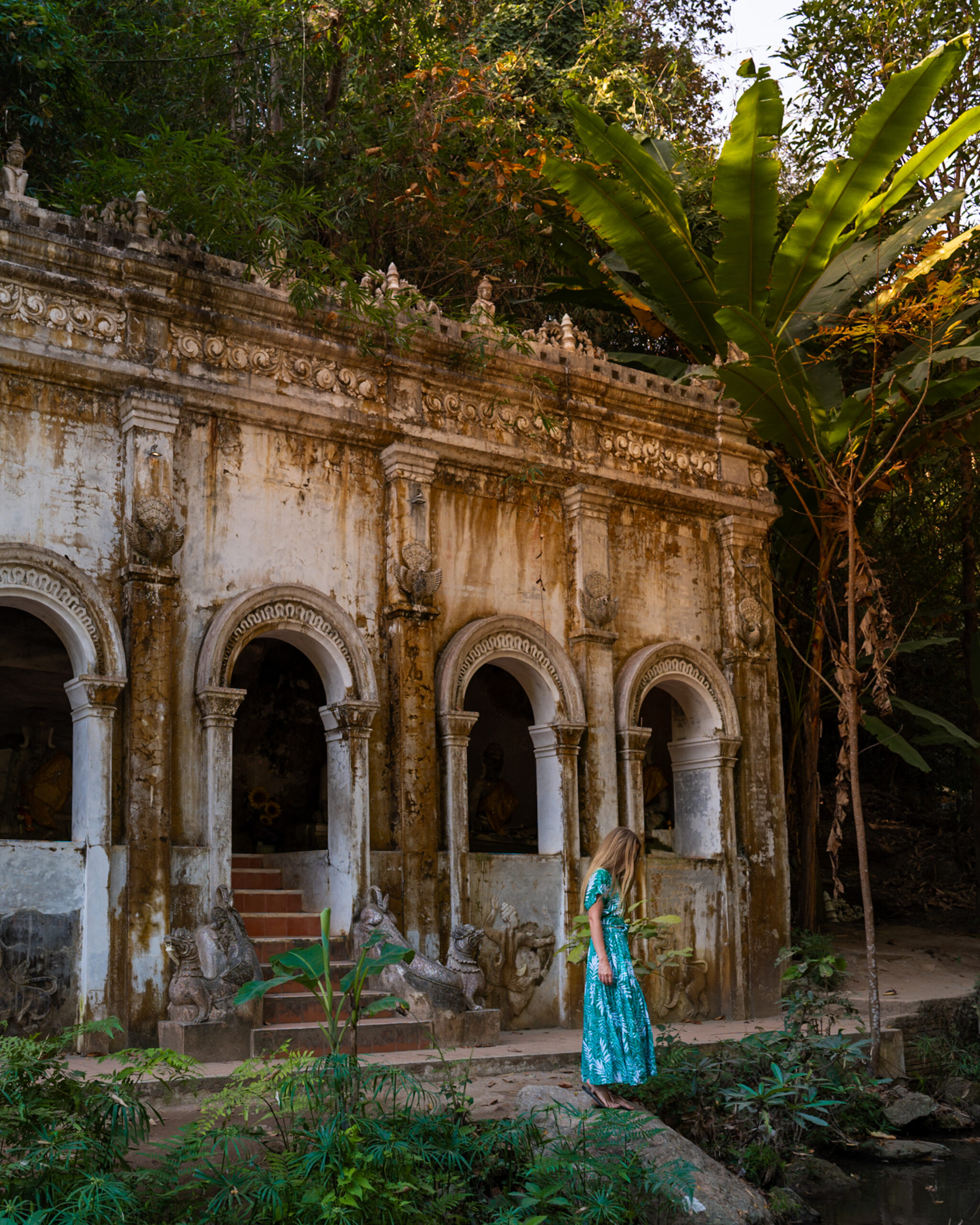
While visiting Chiang Mai in early 2024, I was taken around a number of the famous Chiang Mai temples, markets, umbrella stands and even a few local sights thanks to Thailand Journeys. It was a fantastic way to see the best of Chiang Mai, not only in comfort but with a wealth of knowledge from my fabulous tour guide.
Interested in Thailand trips? Check out Thailand Journeys website here.
Suggested read: Helpful tips for travelling Laos
All about Chiang Mai
First things first… Chiang Mai is located in the northern part of Thailand (otherwise known as the Lan Na region). Famous itself, this city is found between the well known Pai and Chiang Rai towns and is a popular spot for backpackers and holidaymakers. I learnt a lot about Chiang Mai from my tour guide as we departed the city for the surrounding scenery.
Chiang Mai means ‘new city.’ While at 700 years old this may be a subjective take on the world ‘new’, Chiang Mai was designated as the new capital of the Lan Na region, succeeding the former Lan Na capital Chiang Rai. As we were leaving Chiang Mai my guide explained to me that the centre of Chiang Mai is actually shaped like a head. It has a northern, eastern, western and two southern gates (representing the head, each arm and each leg). The north area and north gate is the leadership area, where decisions were made. The west area used to be the royal gardens (but is now a large hospital because needs must a hospital overtakes a garden). The east is the commercial area and this gate is considered to be the commercial gate as product is taken from the city to the river through this gate. One of the two south gates is a spirit gate. If anyone dies in the city, they are taken out of the city via that gate.
How to see Chiang Mai with Thailand Journeys
Thailand Journeys is a reputable tour company that offers private tours across Thailand. Each Thailand Journeys tour has an expert guide who has local knowledge on wherever you are visiting. If you are interested in finding out more about the tours, locations and any extra detail please see their official website here: Thailand Journeys official website.
Exploring the best of Chiang Mai with Thailand Journeys
I spent a full day exploring the best of Chiang Mai with Thailand Journeys and this is what we got up to:
First Stop: Wat Umong and the Tunnels
The first temple and spot on my Chiang Mai tour with Thailand Journeys was to Wat Umong. This temple is of similar age to Chiang Mai at 700 years old. My guide explained that due to Myanmar’s influence, having controlled the Lan Na region of Thailand for 200 years, this temple looks different to other temples found across Thailand.
What gives this temple an extra difference is that it doesn’t just exist above ground but extends into the tunnels below. Once you’ve seen the temple from above you can head into the tunnels and see smaller elements located at different areas of the tunnel.
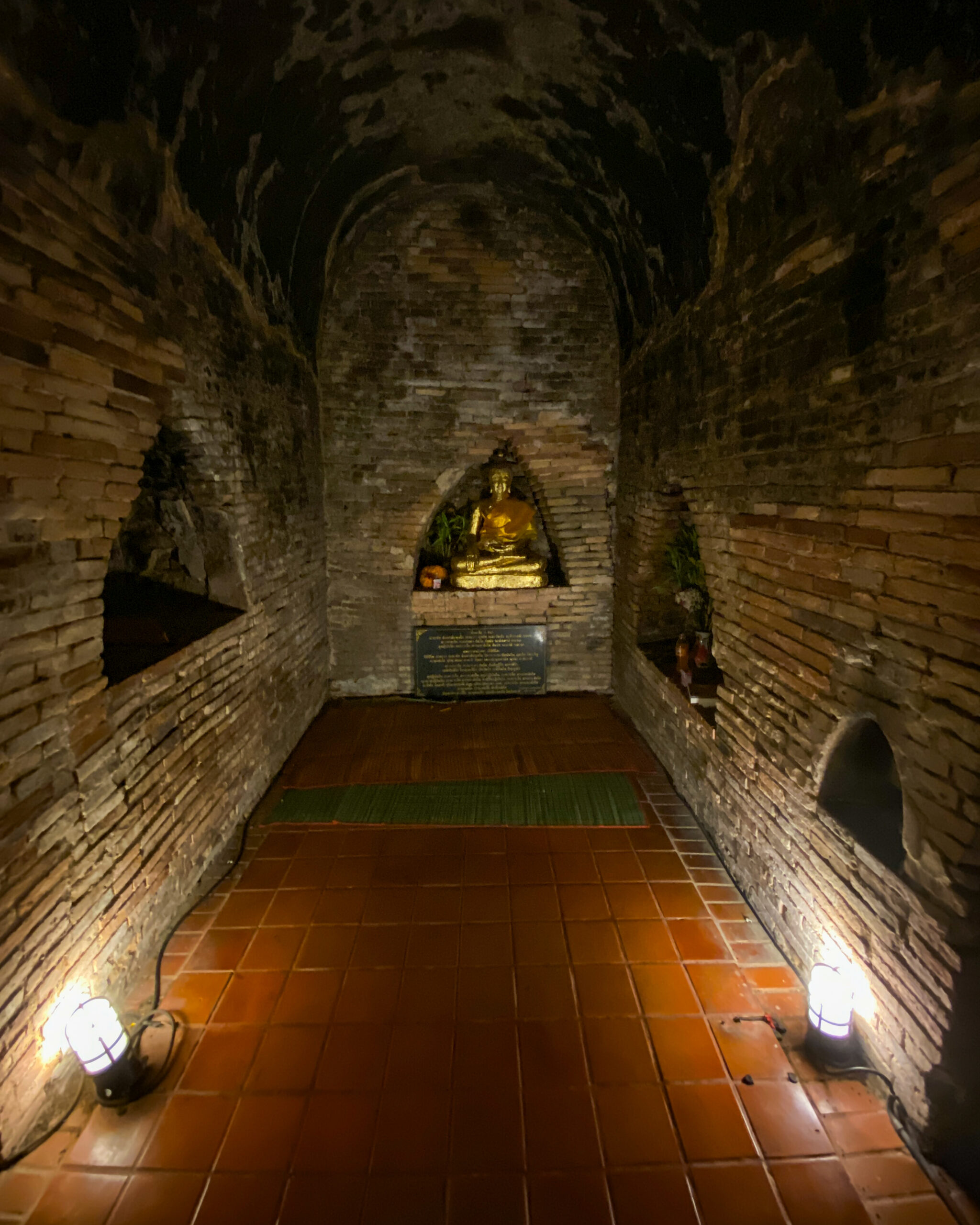
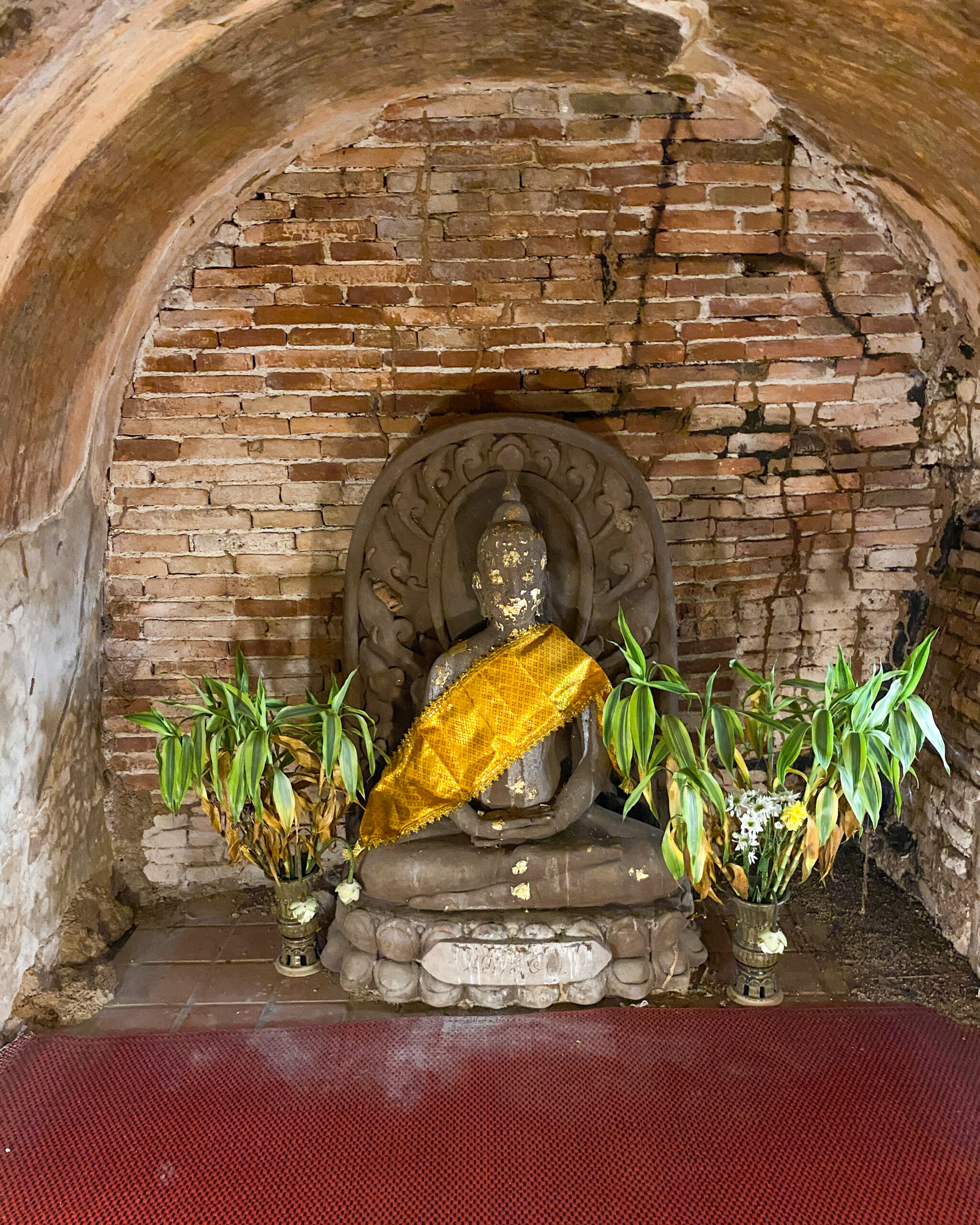
As we explored the tunnels, my Thailand Journeys guide pointed out things I wouldn’t have otherwise seen such as the Thai paintings on the wall. As you can see below the markings are not super clear and the Chiang Mai University has invested into trying to interpret and restore them.
We visited Wat Umong pretty early in the morning (about 9am) and therefore it was quite quiet. However, my Thailand Journeys guide let me know that Wat Umong is the must do temple for Thai people who are visiting Chiang Mai from another Thailand province and that it is especially busy on official Thailand holidays. It was really helpful having a local guide as I gained a much greater insight to Thai life than I would’ve otherwise – for example, my Thailand Journeys guide told me that whenever Thai people go anywhere new they go and see the main temple in the area because doing so is said to bring good luck.
Second Stop: Wat Pha Lat
After we finished at Wat Umong, the next stop on my Thailand Journeys Chiang Mai tour was Wat Pha Lat. Built in the 19th century, Wat Pha Lat is not as old as Wat Umong but I especially loved this Chiang Mai temple due to its calming rainforest atmosphere. Wat Pha Lat is situated about half-way up a mountain situated next to Chiang Mai and as we ascended the mountain, my Thailand Journeys guide told me about how the road we were travelling on was built by monks and Thai people about 70 years ago. The Wat Pha Lat location is heavily embedded in local Chiang Mai life as in addition to being able to drive to Wat Pha Lat you can also hike the mountain to it and, in fact, every year the Chiang Mai University initiates their new students by walking up the track to Wat Pha Lat.
As we explored Wat Pha Lat, my Thailand Journeys guide showed me how Wat Pha Lat differed from Wat Umong by pointing out how the bow and arrow artwork were in traditional Lan Na Chiang Mai style (rather than Myanmar) and that the red flags we saw across the temple are also in the Lan Na style. Wat Pha Lat is also home to a wishing well, which is quite unusual for a temple of this size as normally wishing wells are only found in the bigger temples in the centre of city (as this is where people used to go to get water). Out of all the temples I visited on my Thailand Journeys tour, Wat Pha Lat was my favourite one just down to how calming and relaxing the whole place was.
Third Stop: Phra Borommathat Doi Suthep
We continued up the mountain to the must do temple of Chiang Mai, the Phra Borommathai Doi Suthep. Situated on top of the mountain overlooking Chiang Rai, the Phra Borommathat Doi Suthep is immensely popular so expect there to be crowds, markets and shops. Arriving at Phra Borommathat Doi Suthep is only part of the journey, once you pick up your tickets you’re directed to a cable car elevator style system to take you to the actual temple. If you’d rather walk you can, but the cable car is so convenient.
When we arrived we headed straight to the viewpoint. I visited Chiang Mai in burning season and while I personally wasn’t impacted by this season (and I’ve read a lot online saying that it would be considerably worse than I experienced – I don’t even know if I would’ve picked up it was ‘burning season’ if I hadn’t been told) the view was quite hazy. My Thailand Journeys guide let me know that outside of burning season you can see all the way across Chiang Mai.
What I loved about Phra Borommathat Doi Suthep is that due to its location, when the sun goes down the shadow of the pagoda covers Chiang Mai and therefore it looks like the temple is overseeing and protecting the city.
I learnt even more from my Thailand Journeys guide while here. I didn’t know that the Chinese zodiac uses pigs whereas the Thailand zodiac often swaps out pigs for elephants. The zodiacs are carved into the ceiling in the above picture but show an elephant rather than a pig. However, on the outside frame of the roof, there are pigs as well. My guide explained how often there is a mix of cultures and this is an example of it. She also explained that unlike Christianity which prioritises Sunday as the day to go to church and pray, in Buddhism you can visit temples on any day, whichever one suits your schedule best. She also pointed out that you often see lottery tickets sold throughout Thailand but especially at temples. She said that Thai people often wish for luck and money, so what goes better than purchasing a lottery ticket at the same time.
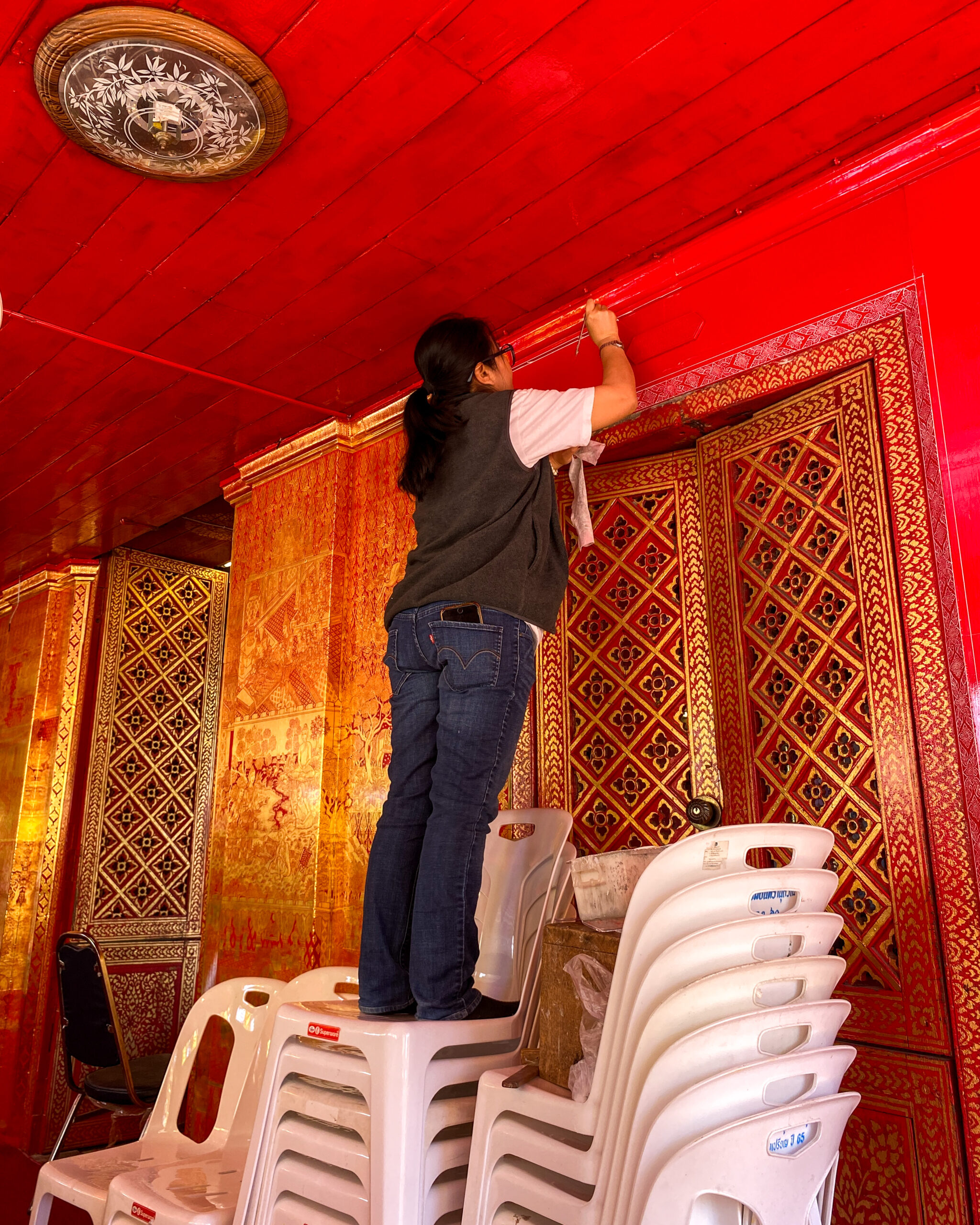
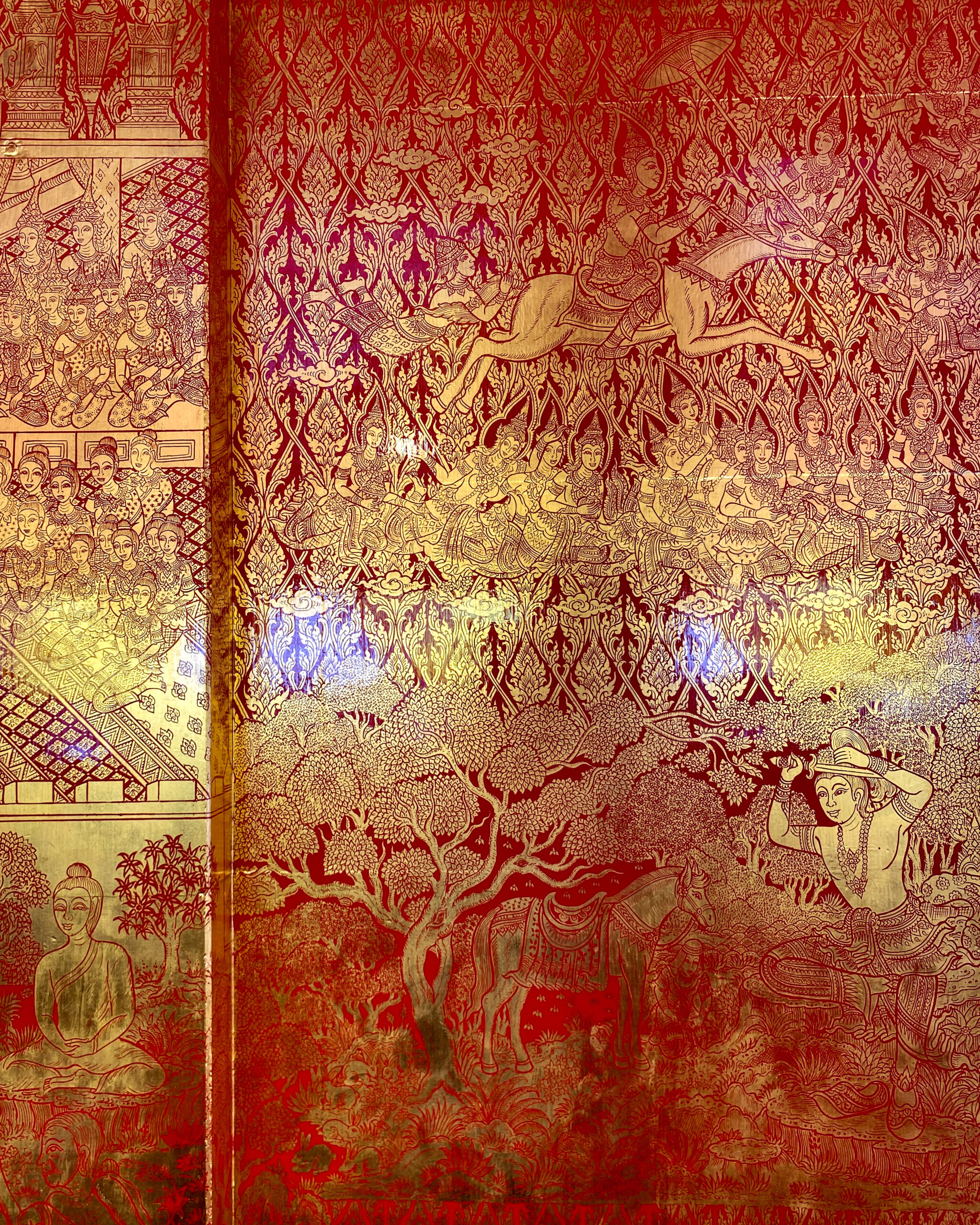
Throughout the temple there were impressive gold paintings. My Thailand Journeys guide explained to me that these paintings are added to the wall by hand and we were able to sit for a while and watch the painters at work.
Fourth Stop: Bor Sang Umbrella Making Centre
After we left the temples, we travelled across Chiang Mai from the west to the eastern side. The eastern side of Chiang Mai is well known for making things and I was eager to see the umbrella village of Chiang Mai. My Thailand Journeys tour took me to the Bor Sang Umbrella Making Centre in eastern Chiang Mai. This umbrella making centre has been around for about 30 years but umbrellas have been made on the streets and surrounding houses for far longer. Bor Sang is so well known it has hosted famous guests like Princess Diana.
The monk Luang Por Inthaa (the same one who helped develop the road to the temples in western Chiang Mai) is credited with bringing the idea of umbrella making to Chiang Mai. It is said that he saw the umbrellas in Japan and liked them so much he brought the concept back to Chiang Mai where it took off.
My Thailand Journeys guide took me through the process of how paper umbrellas are made from scratch, which was very impressive. Firstly they take the bark from trees, dry it, boil it and spin it before breaking it into smaller pieces with hammers. From there it is put into water, stirred and picked up with a special square carrier (see the photos below). The colour of the paper is chosen while it is in the water as the water is full of whatever dye the paper will be. Once removed from the water, it is then put out to dry.
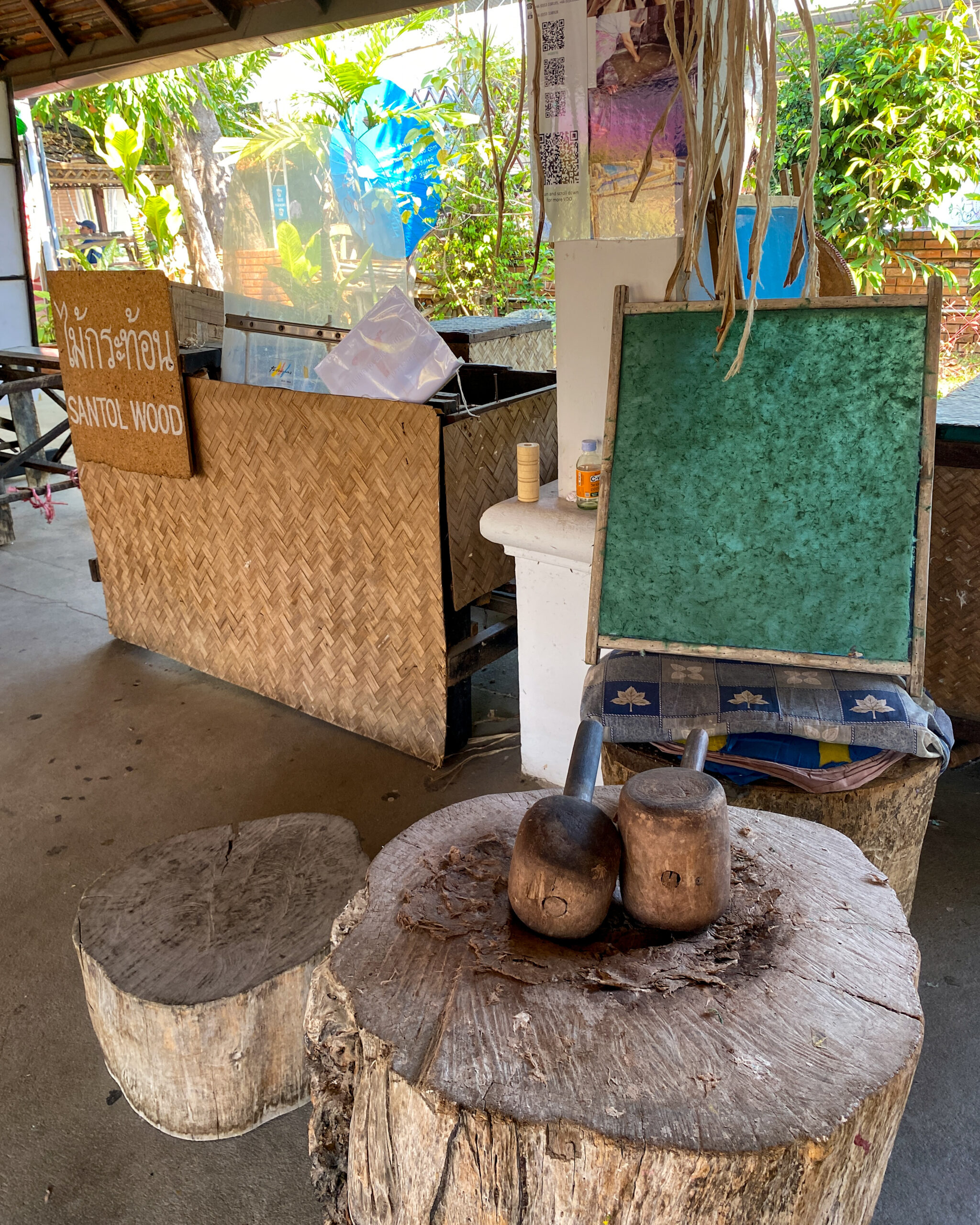
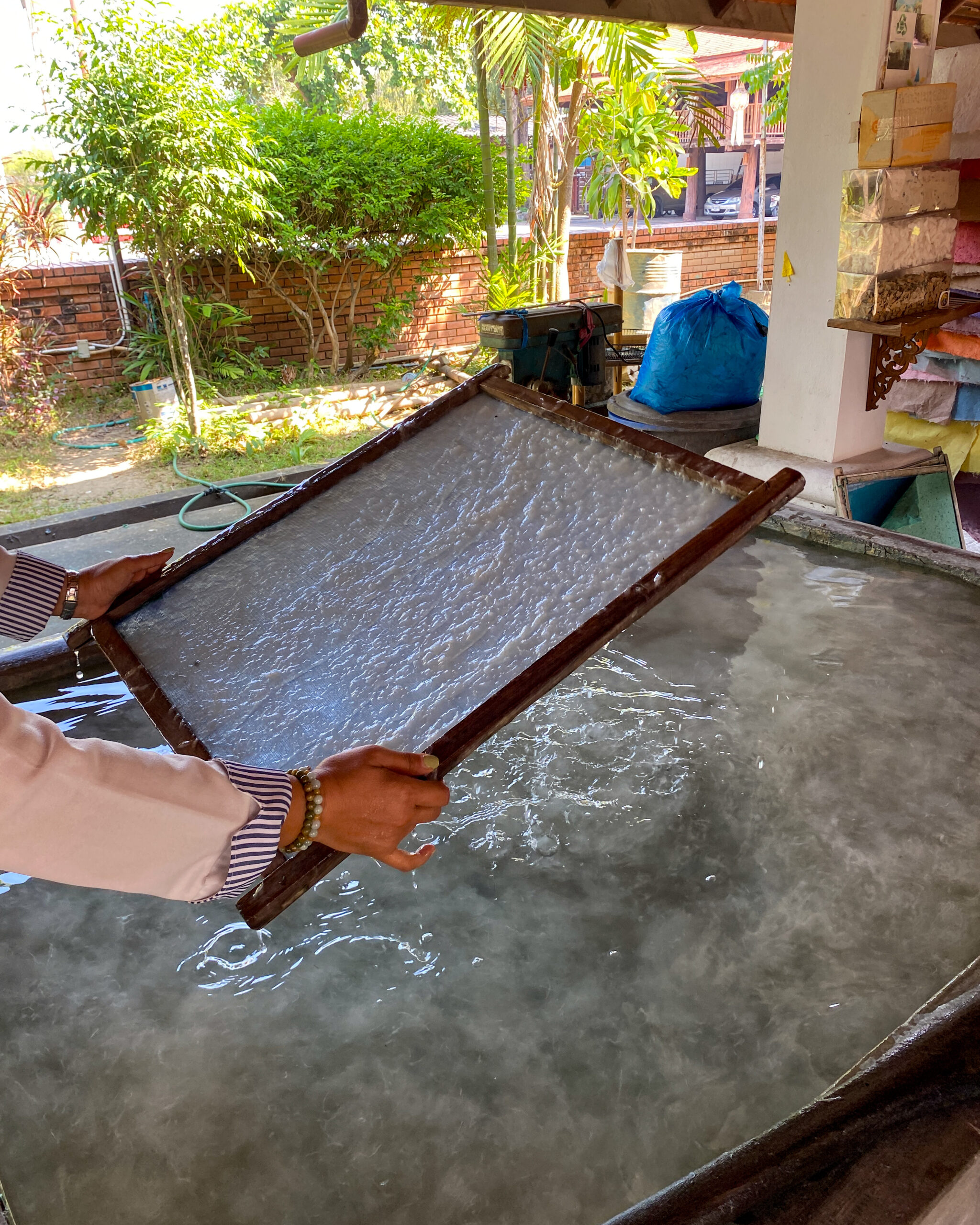
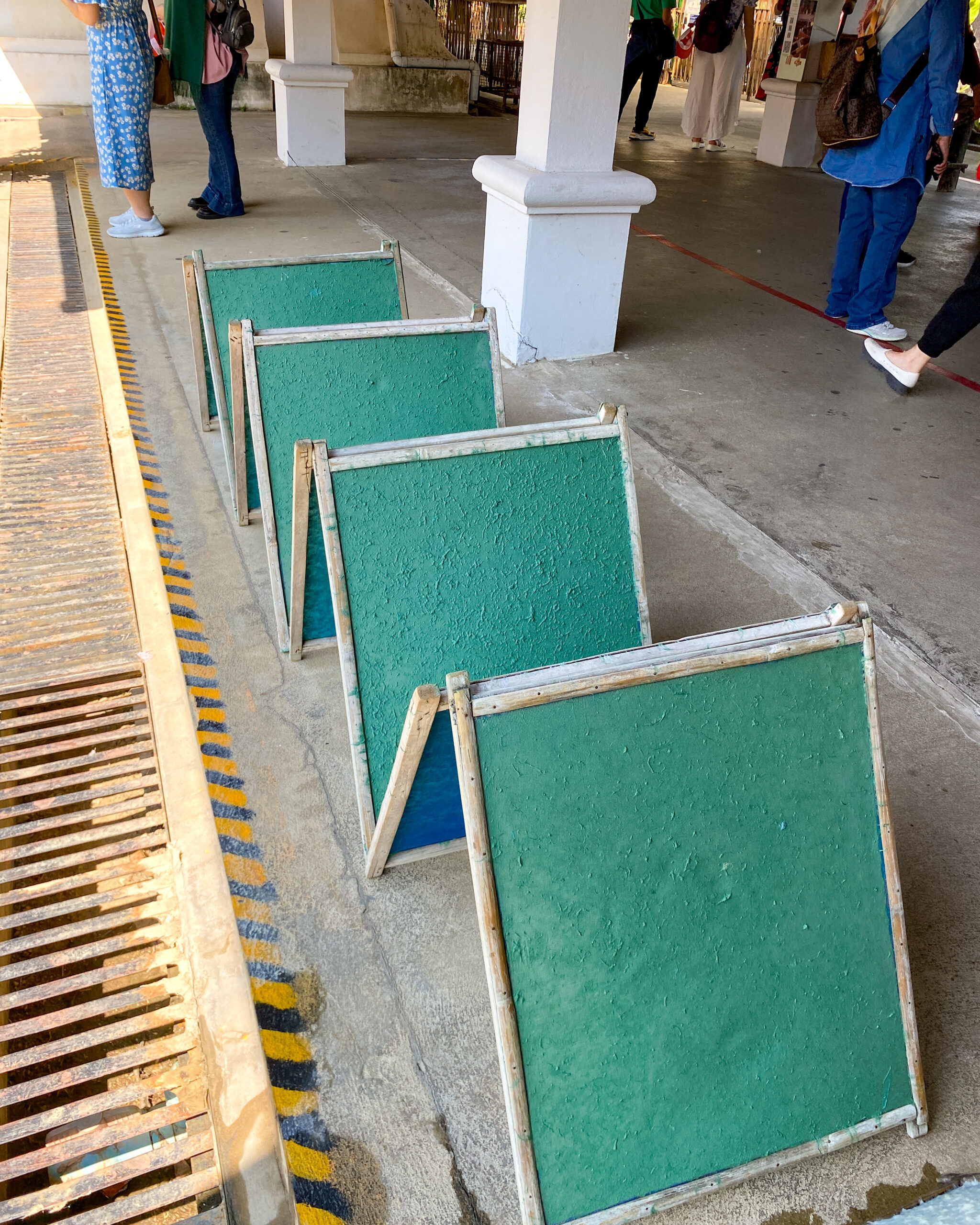
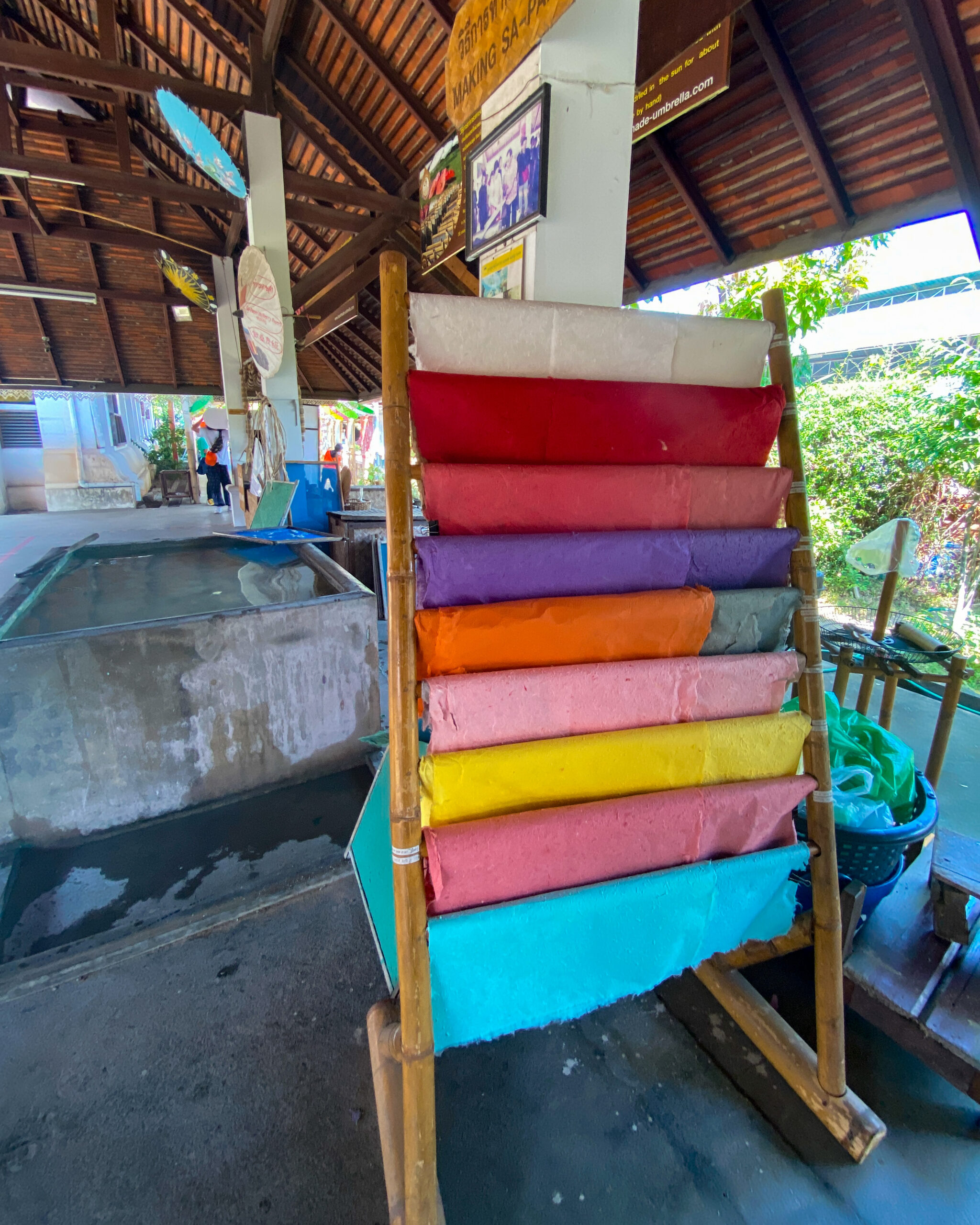
While the paper is drying, the structure of the umbrella is made and then the paper is added on top. Once the umbrella exists in this format, they then paint the different patterns across it.
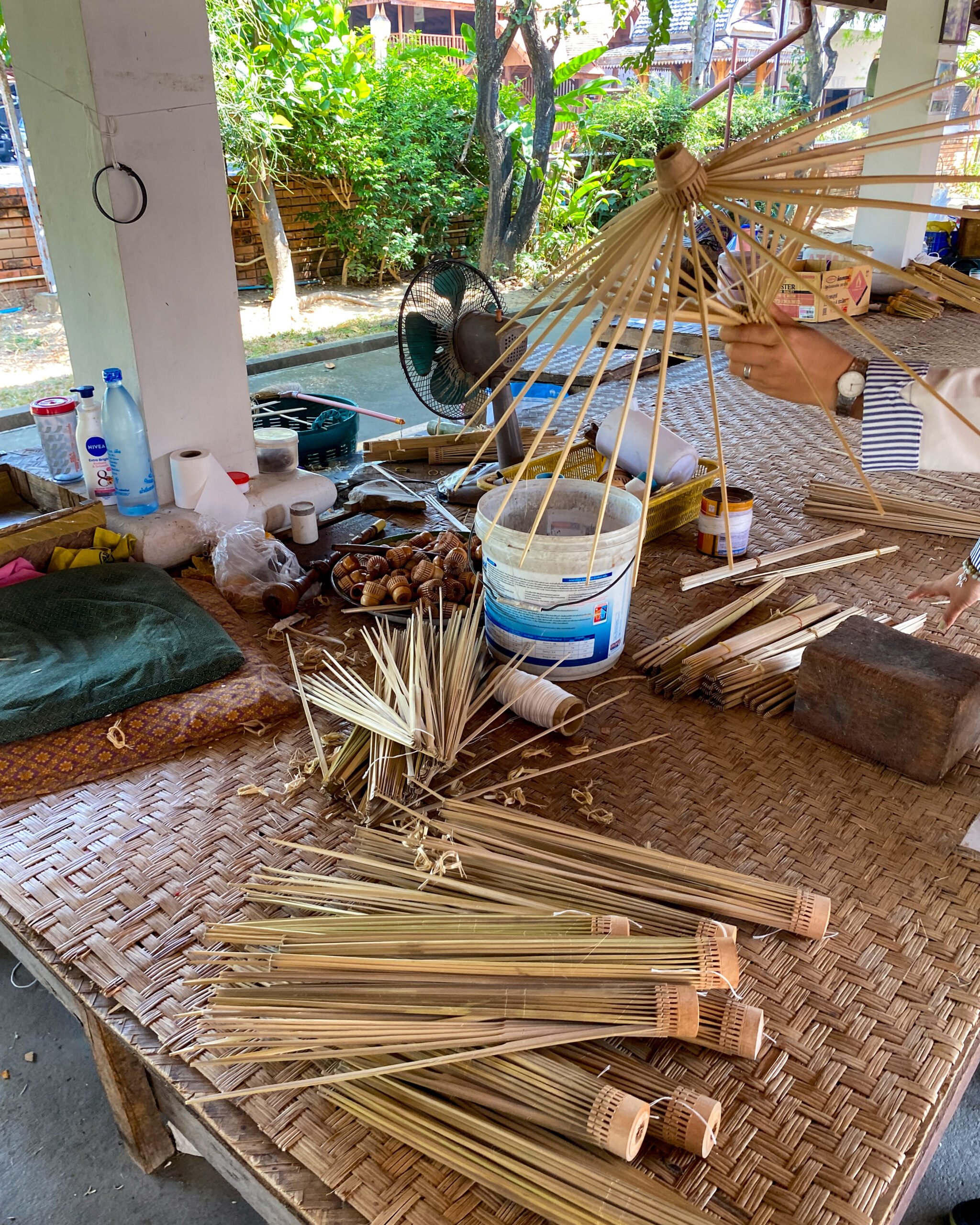
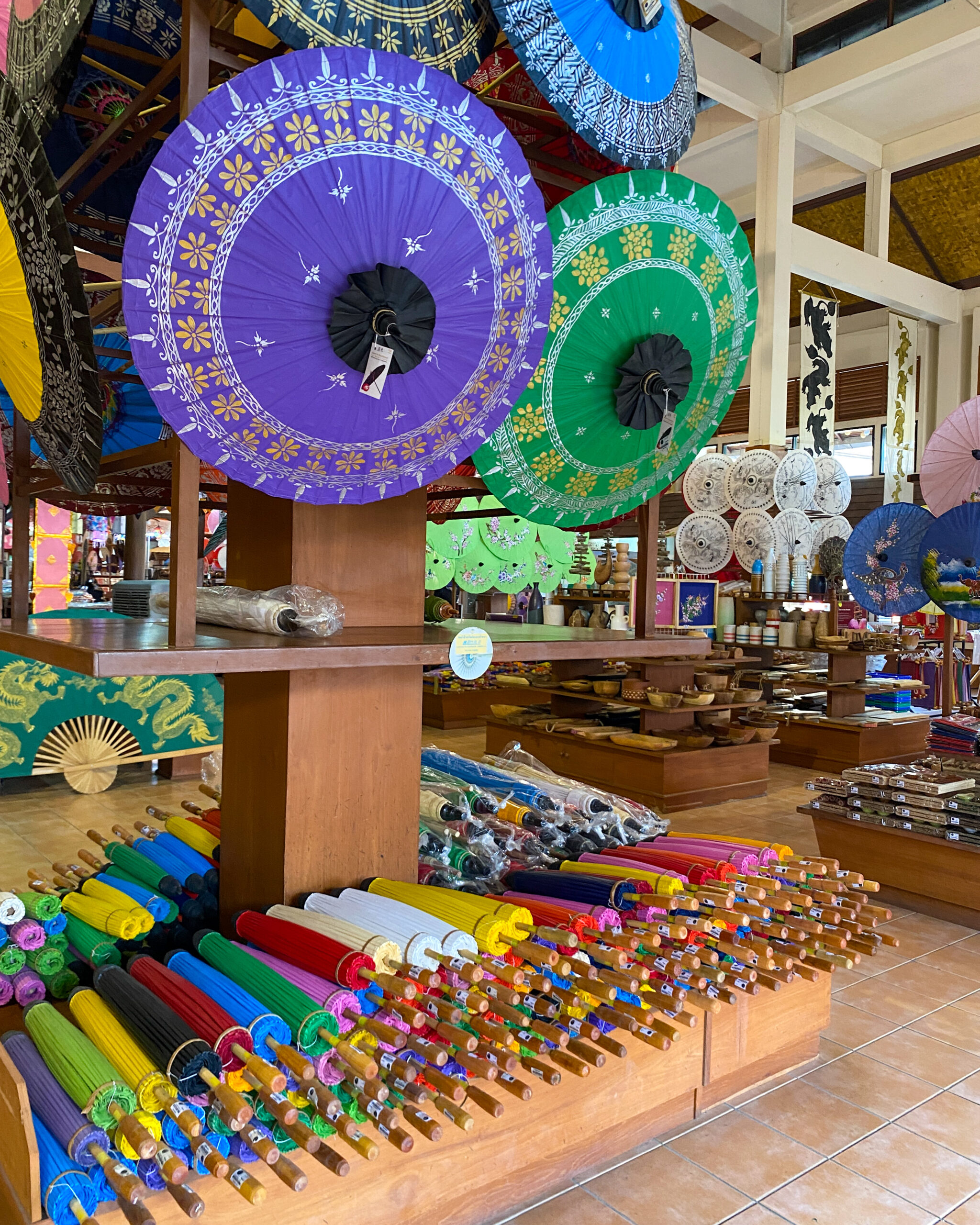
Thailand Journeys Chiang Mai Tour: Break for Lunch
After spending the morning exploring three of the famous Chiang Mai temples and the Bor Sang Umbrella Making Centre it was time to break for lunch. My Thailand Journeys guide took me to a restaurant that despite its popularity had very good prices (60 Baht – that’s about $2.55AUD or £1.35).
The most famous dish from Chiang Mai and Northern Thailand is Khao soi, which is an egg noodle coconut milk curry dish. The traditional version is with chicken, although you can get versions with prawns if you prefer. I found it absolutely delicious but I am a sucker for coconut anything.
As we were leaving lunch, my Thailand Journeys guide pointed out flowers on a nearby bush. Again, this was a real benefit of having a local guide as so many tours take guides from any country who don’t have the grown knowledge of the area they are showing. My Thailand Journeys guide showed me how the vibrant blue from these flowers rub off really easy and is often used to make flower tea (literally combining the flowers with boiling water) but also in ice cream and other food where you want a blue dye.
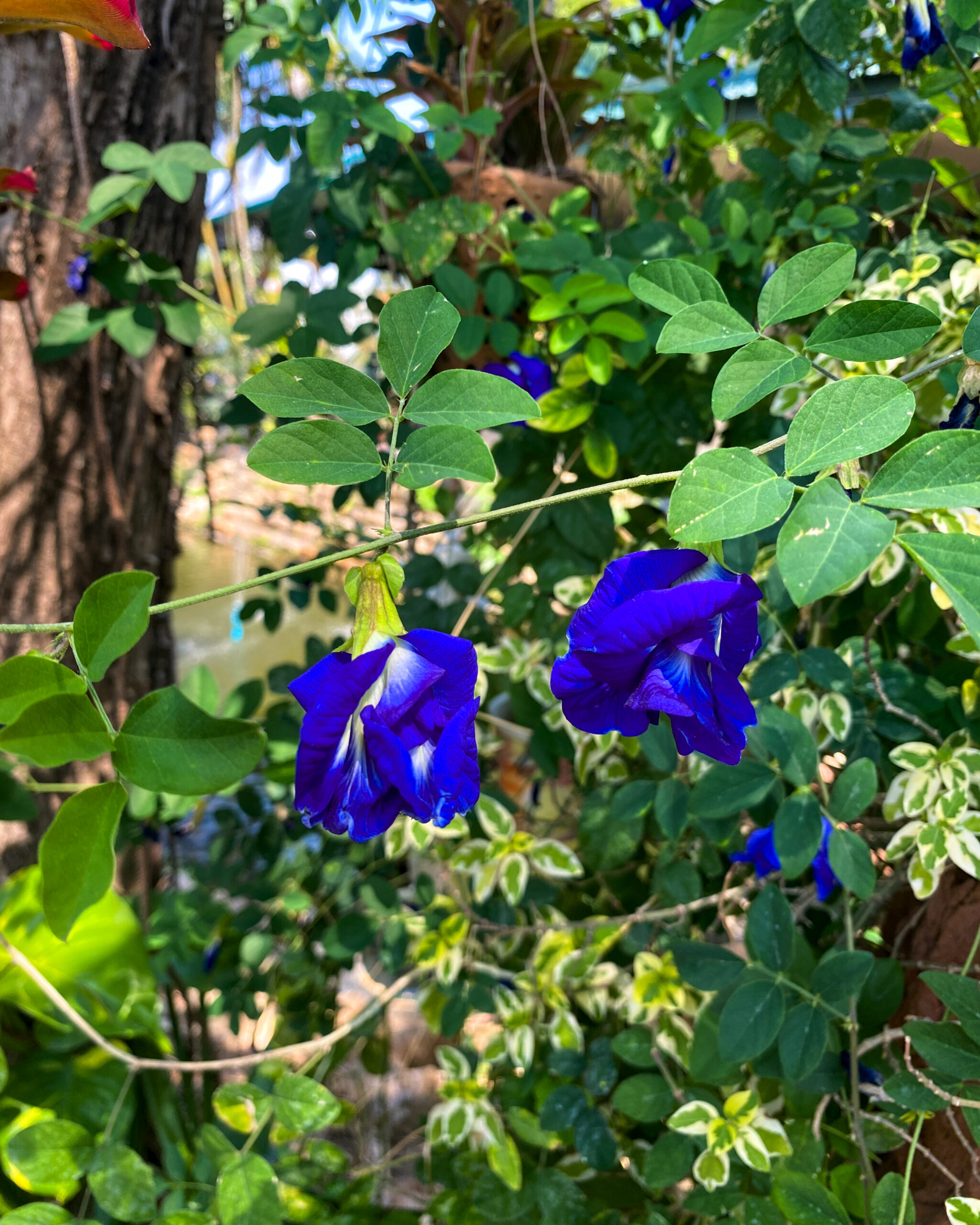
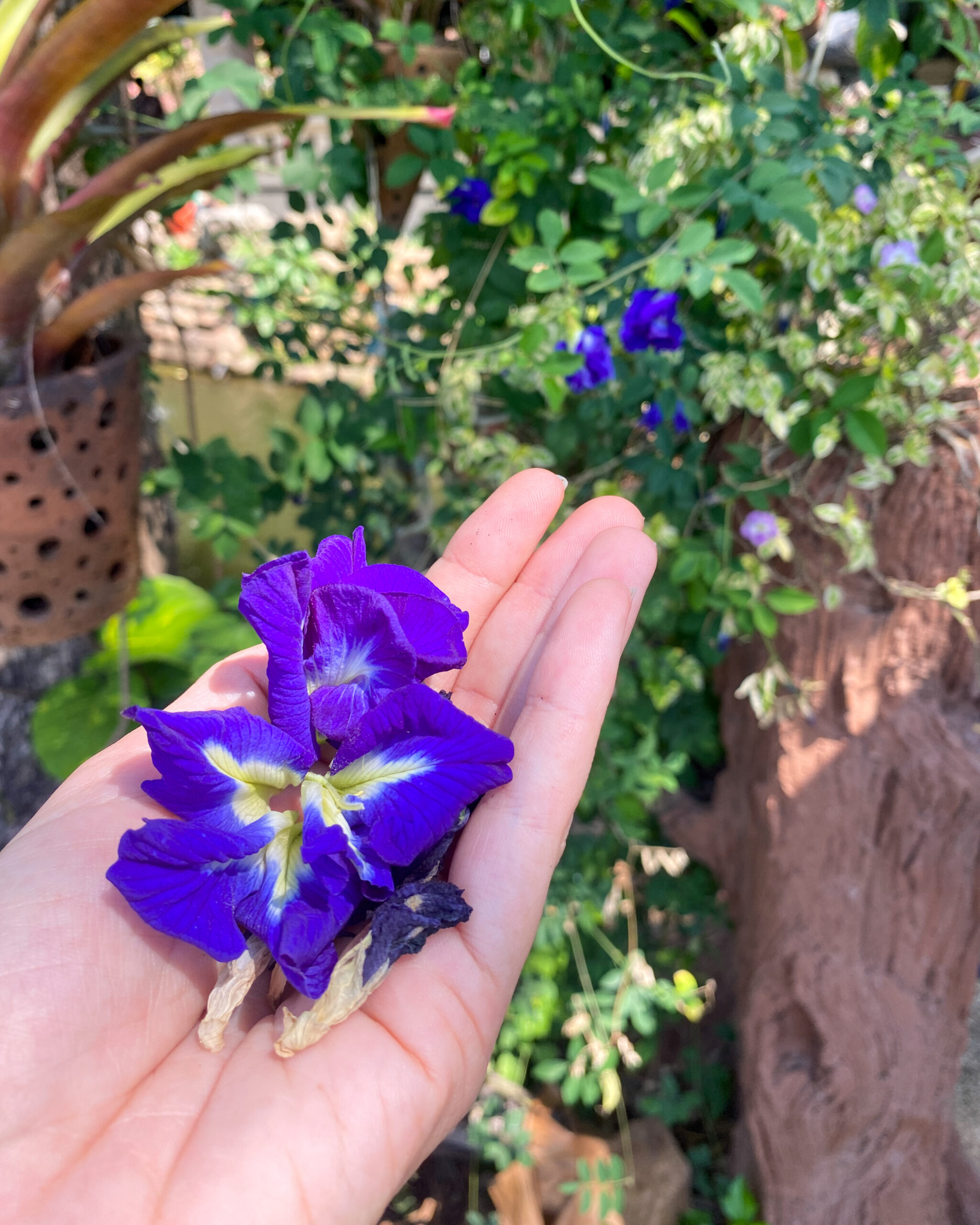
Fifth Stop: Wat Phranon Mae Pukha
After we left lunch, we ventured to a local temple. This was quite a pleasant change from the earlier temples we had explored in Chiang Mai as this one was not really on the tourist trail and more telling of real local life in Chiang Mai. Wat Phranon Ma Pukha was created sometime in the last 100 years and has been influenced by Myanmar, which you can see in the style of buddha at the temple. Myanmar buddhas tend to have red lips as Myanmar people still believe that the Buddha is alive and the red lips indicate living. My Thailand Journeys guide explained that a lot of Myanmar people will have red in their temples, and if you see a Buddha with red, even outside of Myanmar, it has been influenced by the Myanmar style.
My Thailand Journeys guide told me how reclining buddhas (ones lying on their side) have been around for about 700 years and that the reclining indicates sleeping or dead. She also explained so much more than what I could’ve ever hoped to have learnt by myself. We went past the below pots and my guide explained how these pots were a big part of Thailand culture. Before you could buy water as you can today, these pots would be at the front of people’s houses with coconut shells to be used as cups that anyone going past the house is welcome to drink from – a real sense of community.
The monk was born in the Year of the Tiger and so Thailand locals often gift this temple with miniature tigers as a sign of respect.

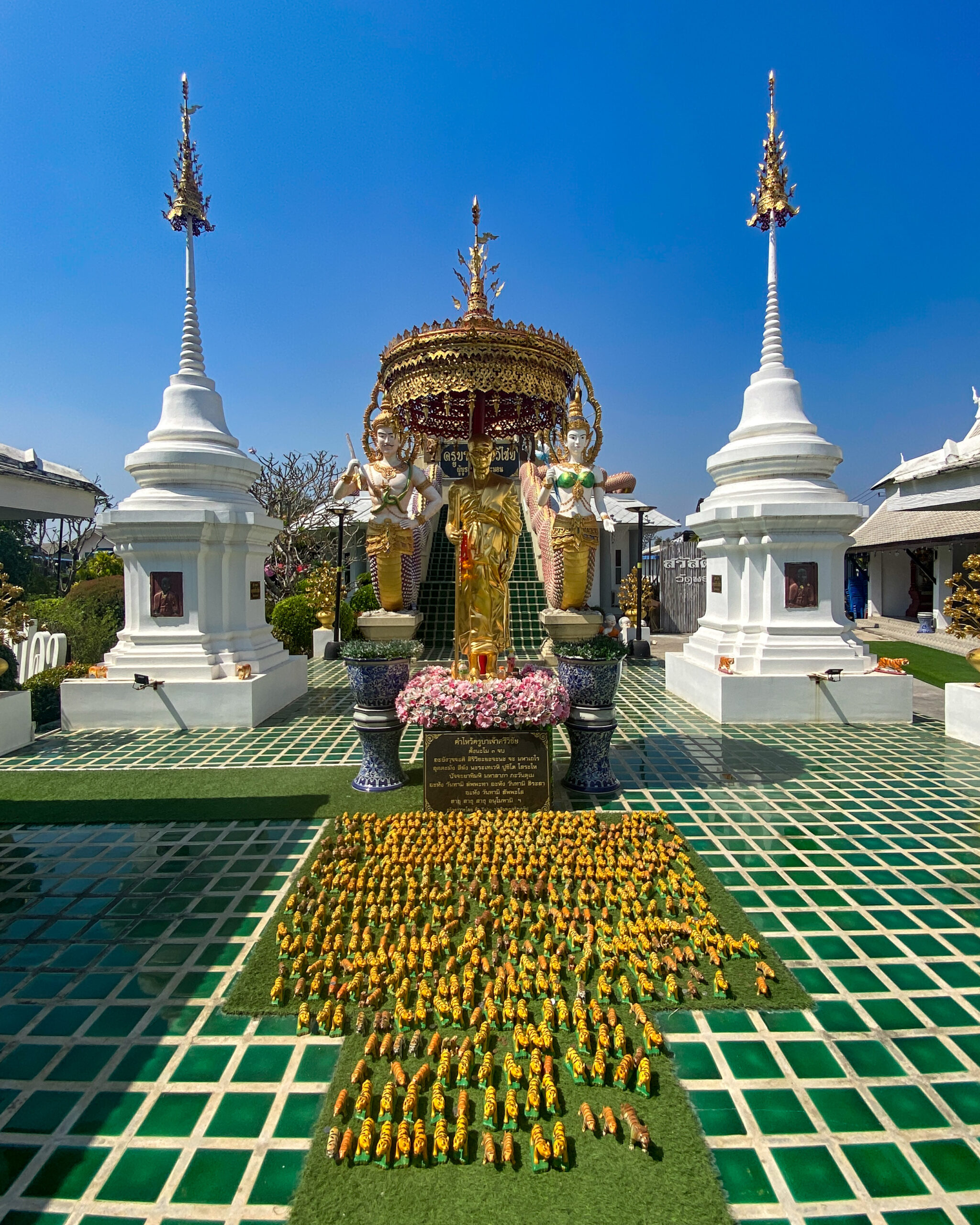
Finished the Thailands Journey Chiang Mai tour at the Chiang Mai markets
To wrap up the day exploring the best of Chiang Mai with Thailand Journeys, we headed to the Warorot Markets in China Town. Despite being just down the road from Chiang Mai Night Bazaar, my Thailand Journeys guide assured me that the pricing was considerably cheaper here (local vs. tourist price). The Warorot Market is known for being able to buy everything from and after visiting I can easily see how that is the case. With both wholesale and retail available, as well as numerous food stalls, both for immediate consumption and to have later. Prices were cheap for western standards with shirts and jeans advertised at 100 Baht ($4.25AUD or £2.20). My Thailand Journeys guide showed me around all the places she likes to eat and buy from and it was great (I sound like a broken record but it’s true) getting a local perspective on Chiang Mai.
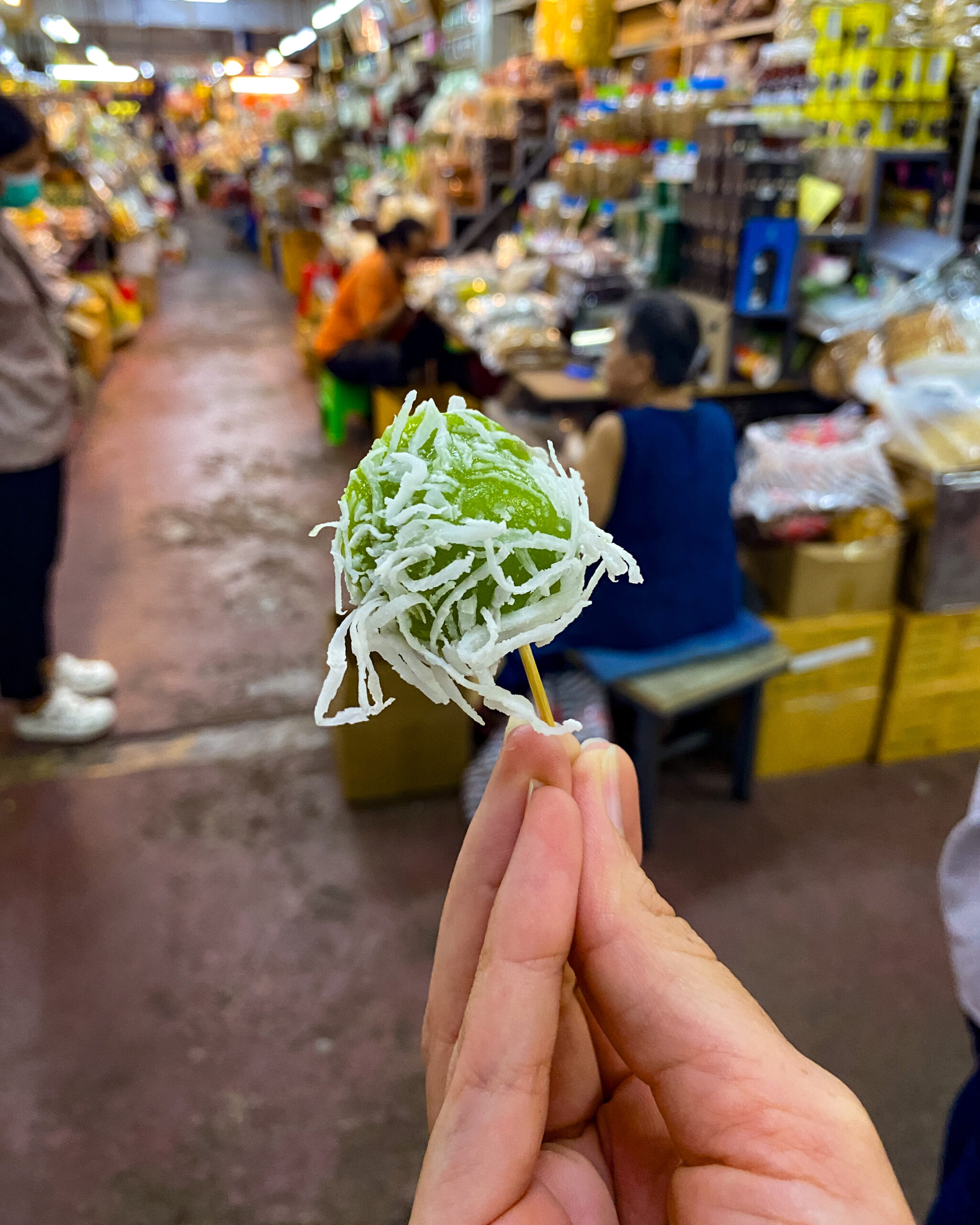
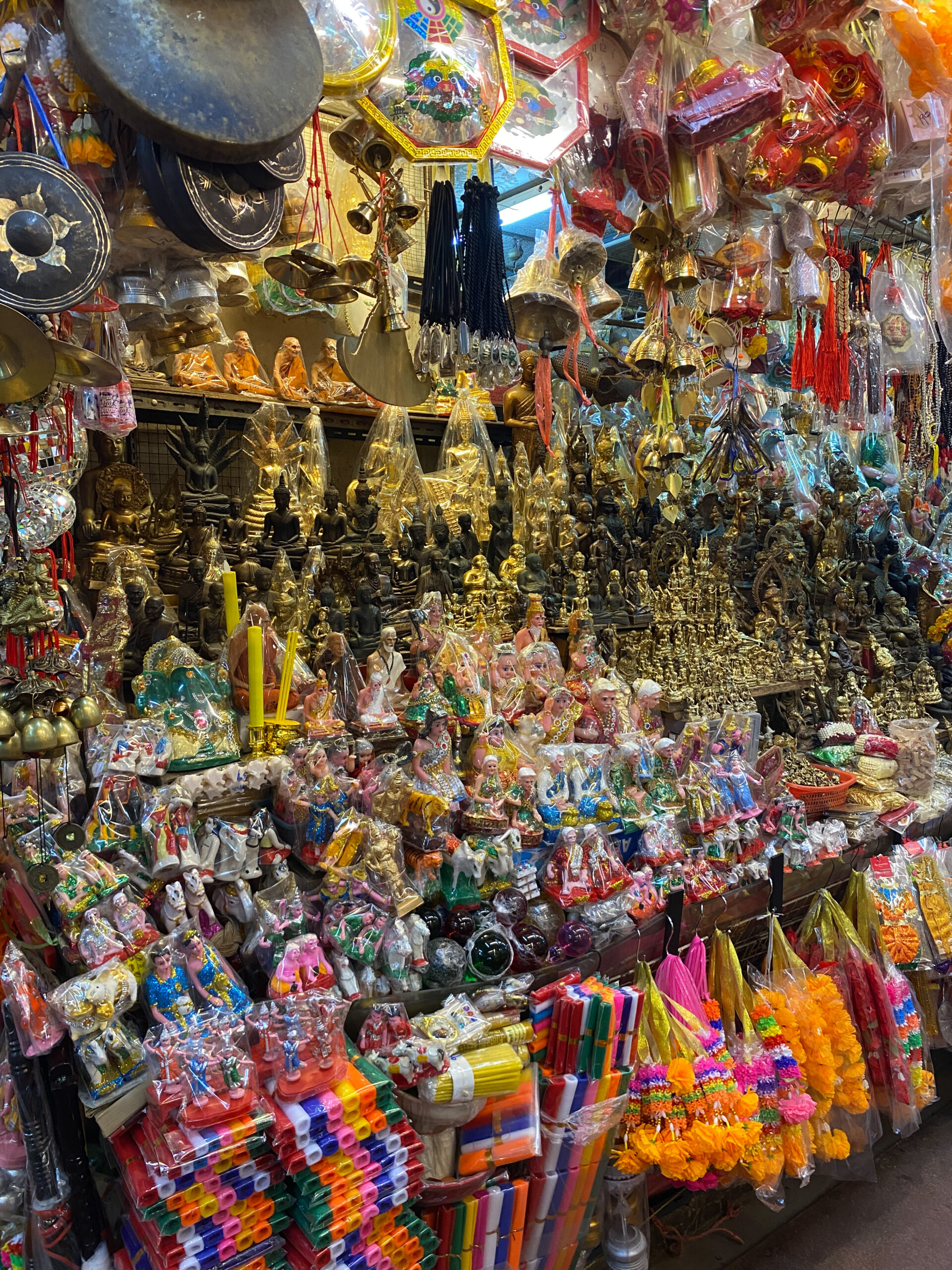
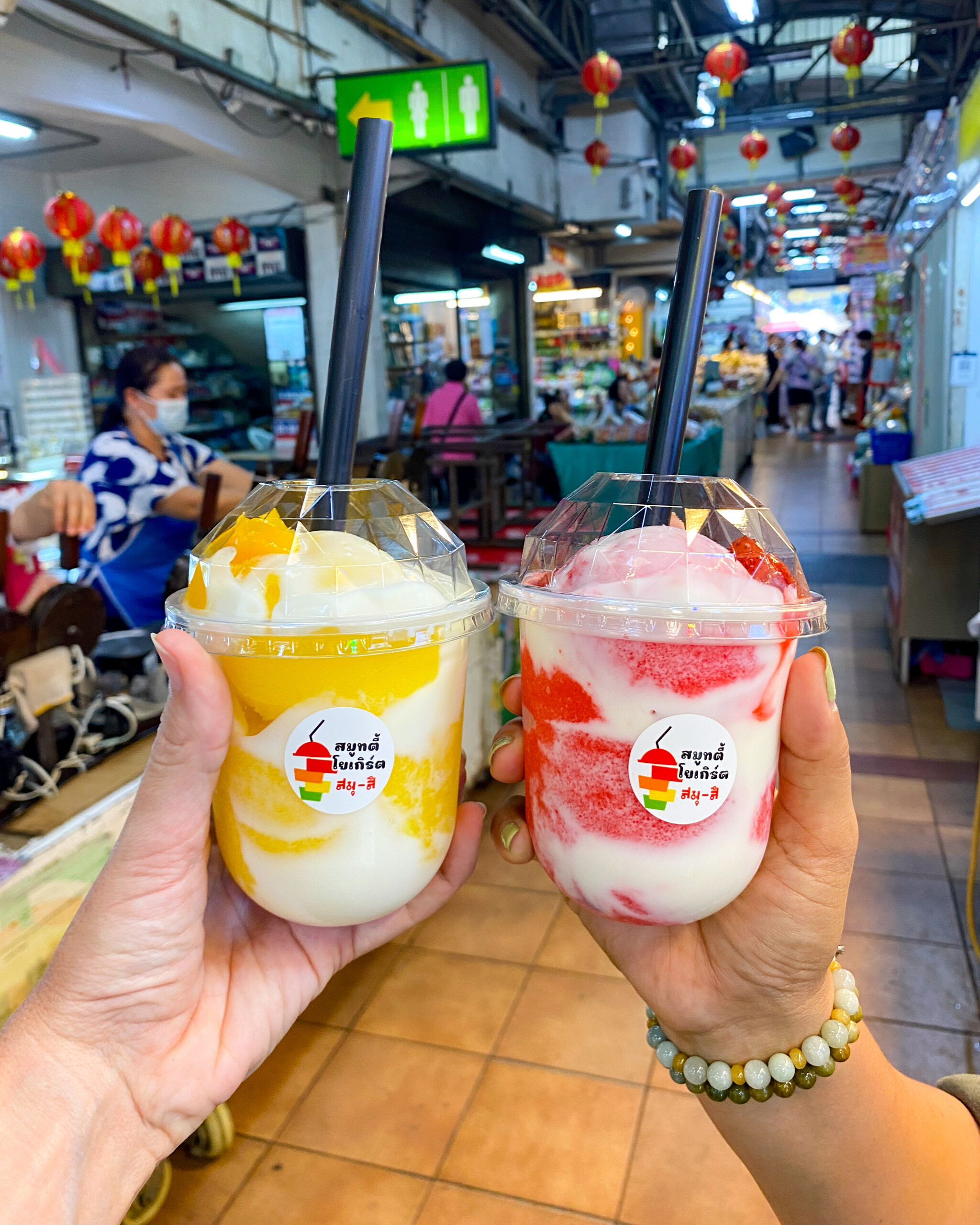
The Warorot Market continues onto the flower market and, as we were visiting only the day before Valentine’s Day, it was absolutely bustling. Such a lovely way to finish the day exploring Chiang Mai with Thailand Journeys.
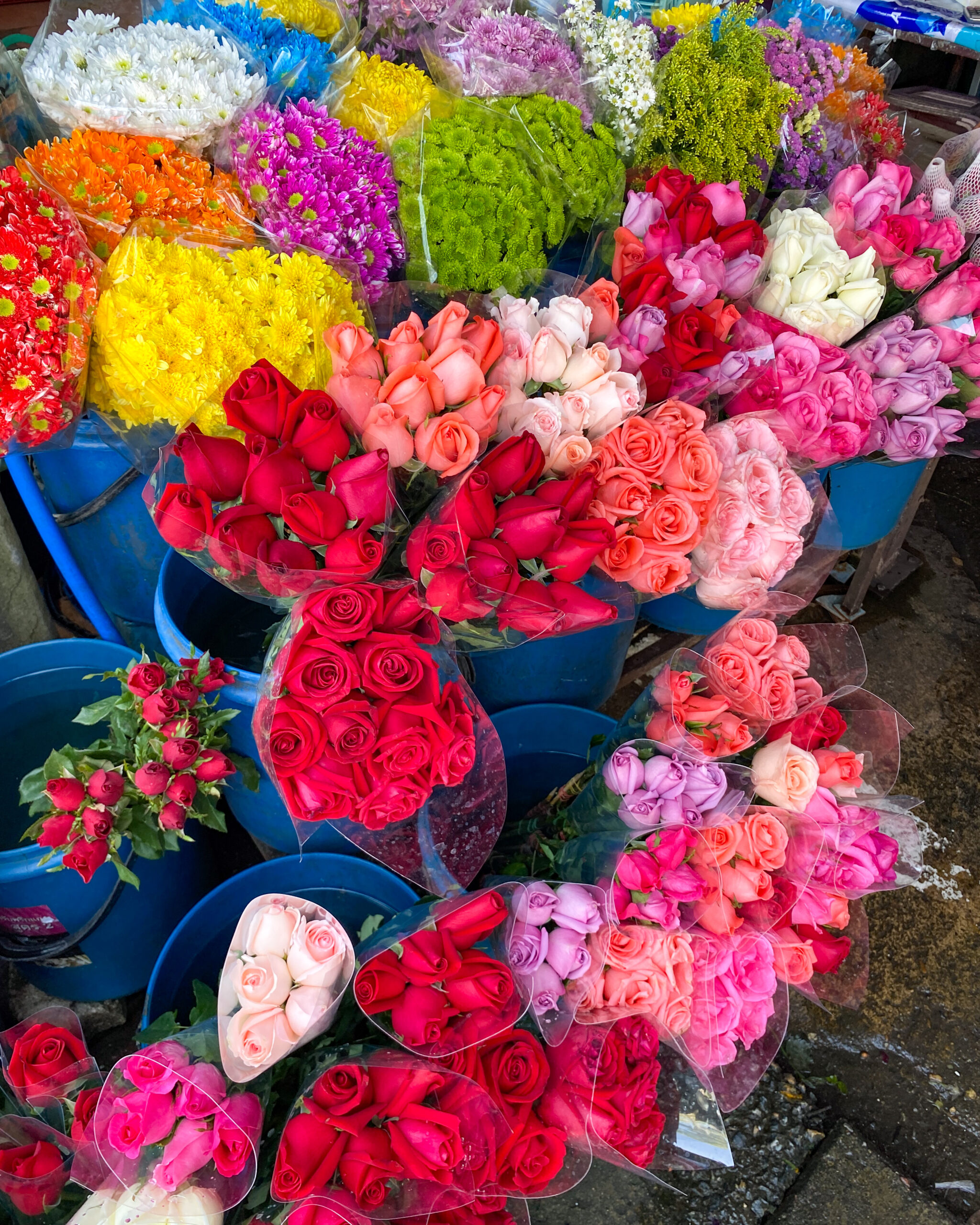
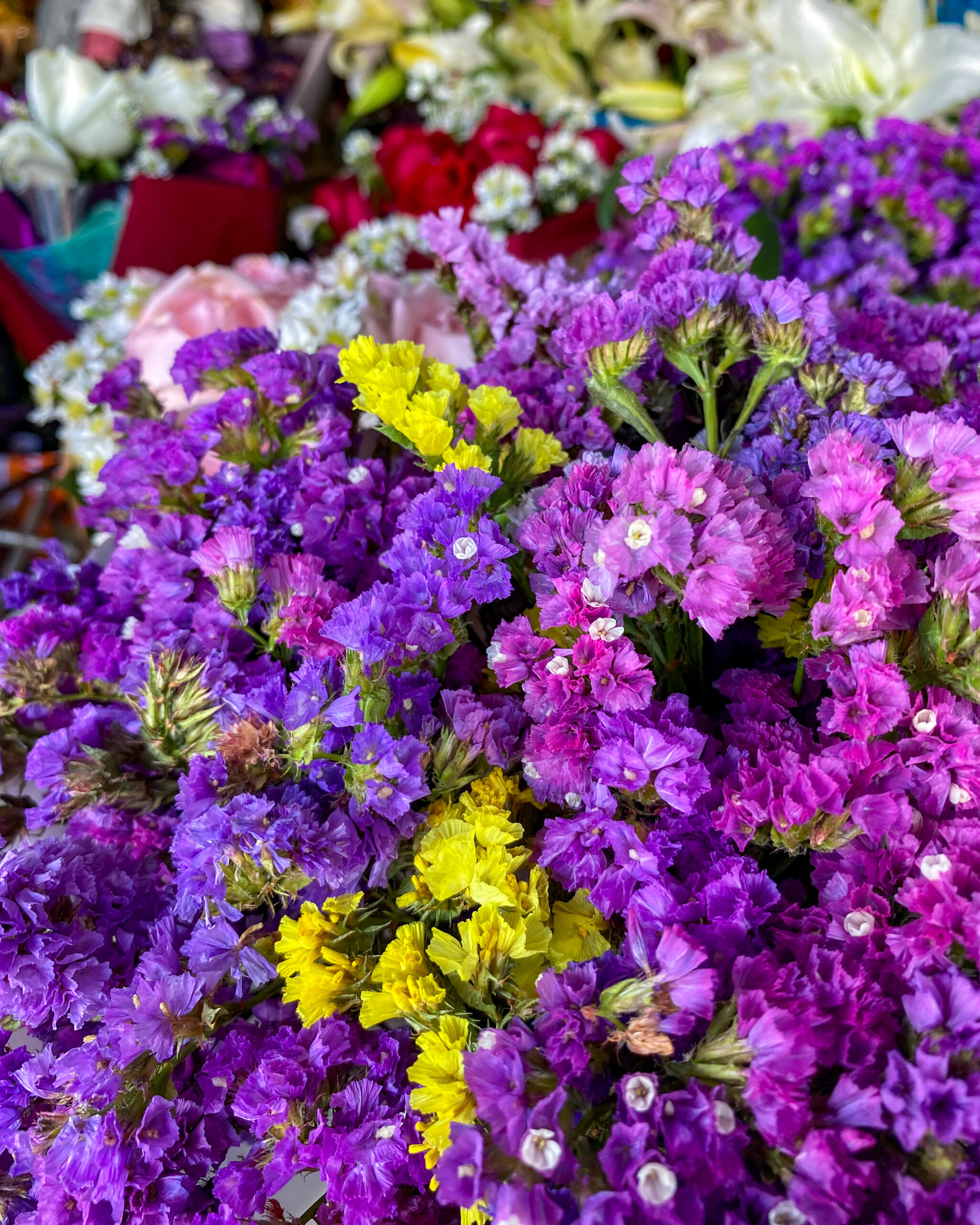

If you want to learn more about how to explore Chiang Mai or other areas of Thailand, please visit Thailand Journeys official website: Thailand Journeys.
I explored Chiang Mai with Thailand Journeys as a part of a collaboration. For more information on my disclaimer and how you can work with me see: Work With Me.
If you are interested in Exploring Chiang Mai with Thailand Journeys, you may also be interested in:
- How to spend two days in Chiang Rai
- Practical tips for taking photos at the famous Chiang Rai temples
- How to get to Railay Beach from Ao Nang in Krabi
- Helpful tips for travelling Laos
- First time in Vietnam: The best things to do in Vietnam for first-timers
- How to get to the famous Hanoi Train Street

